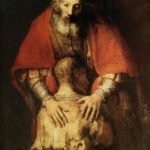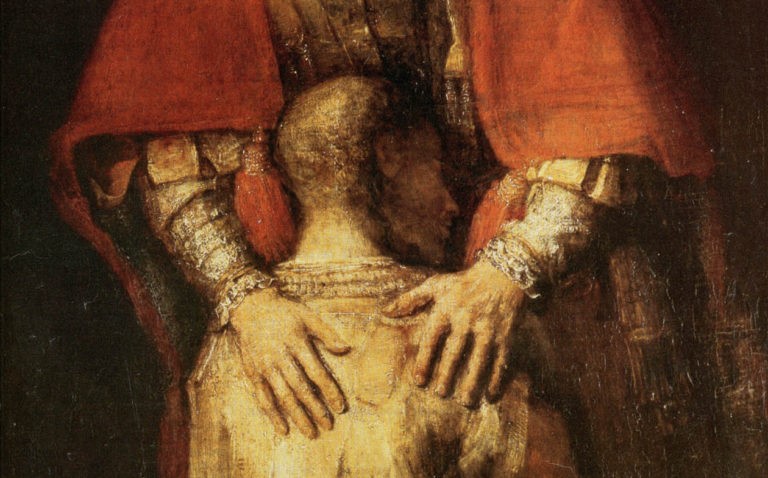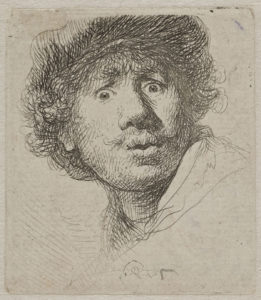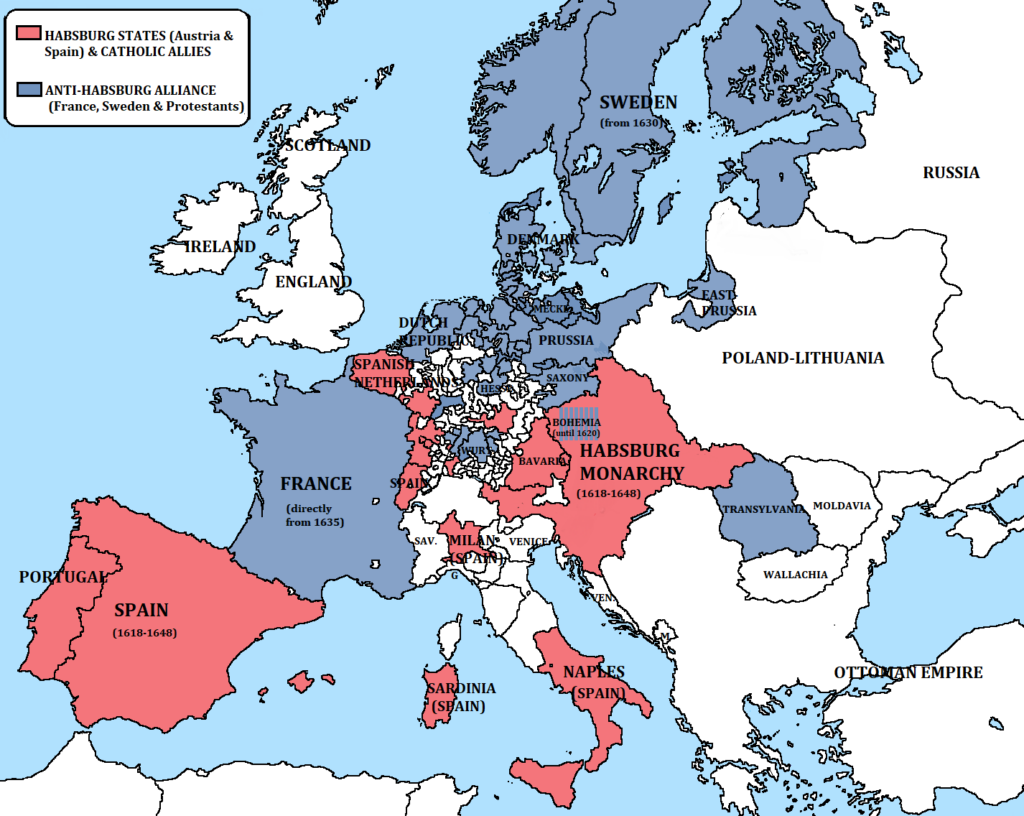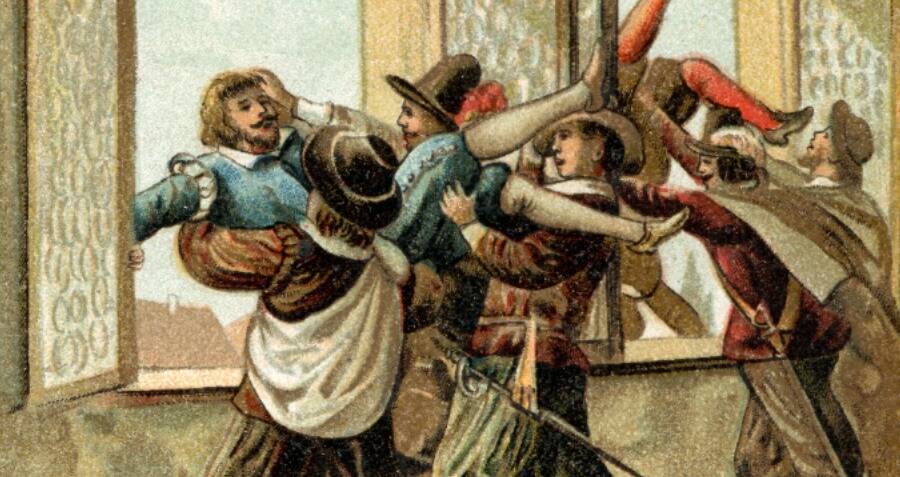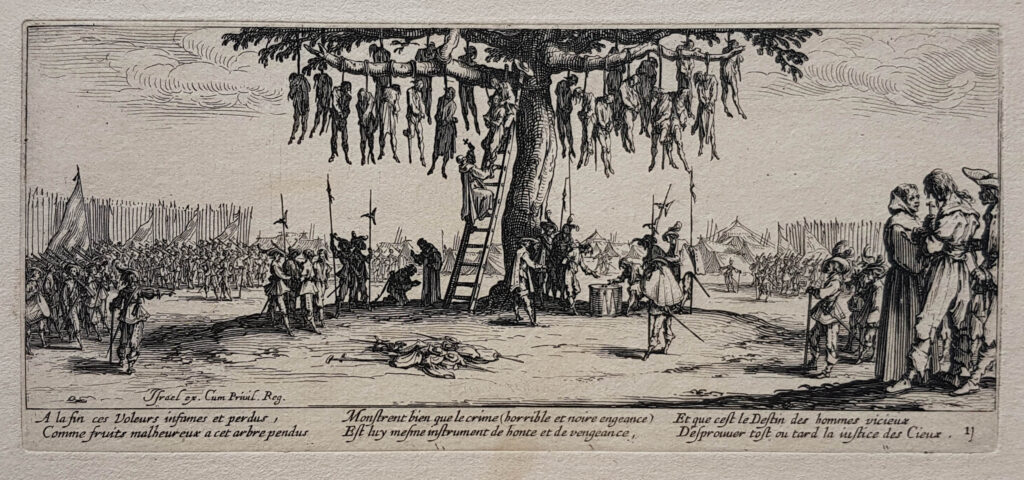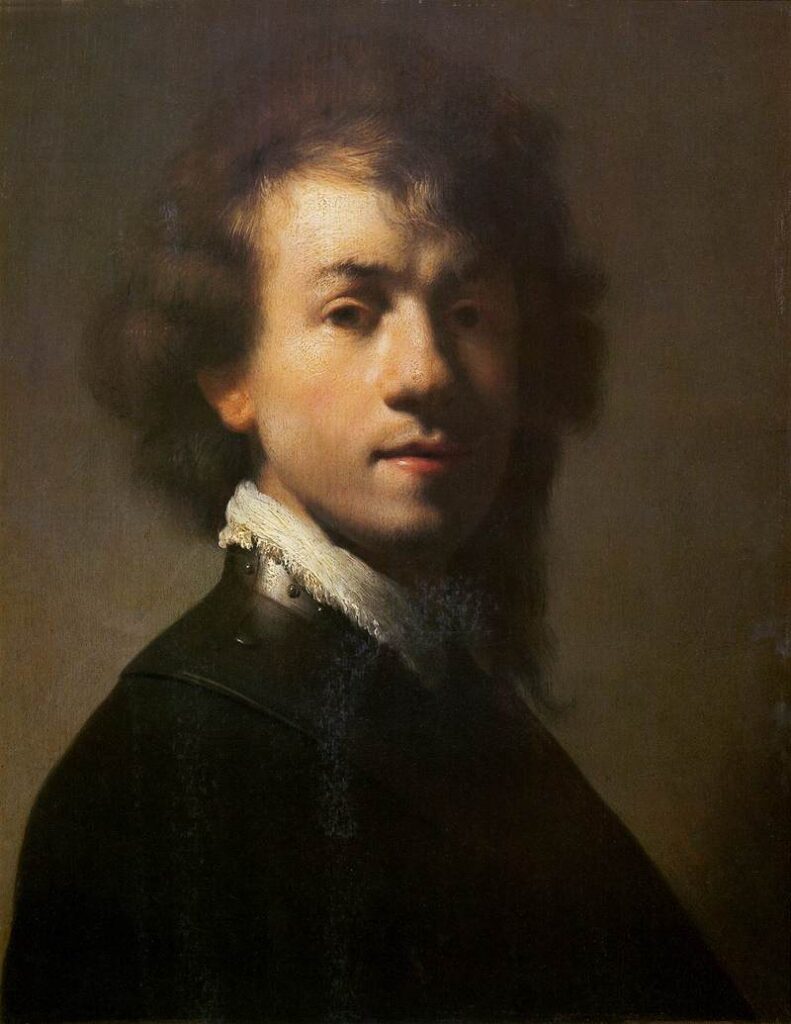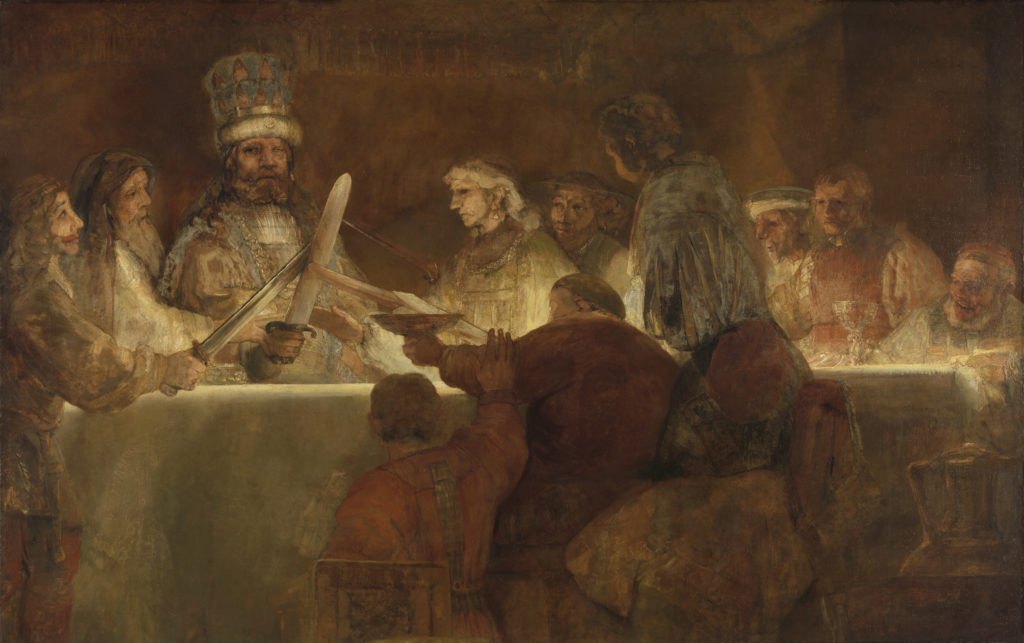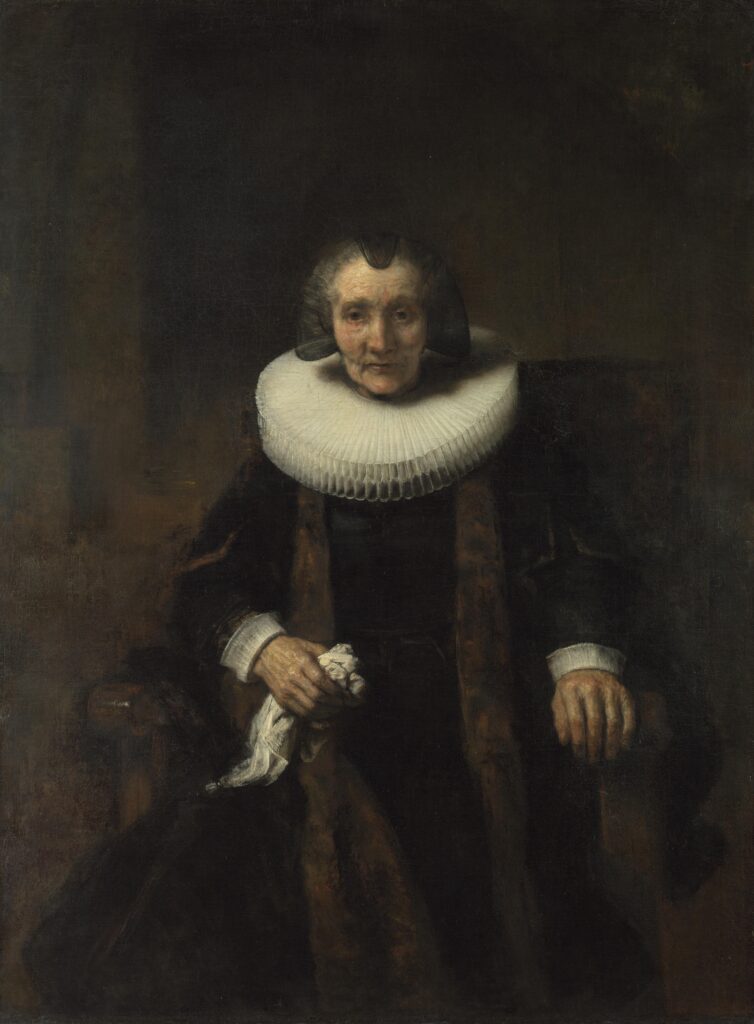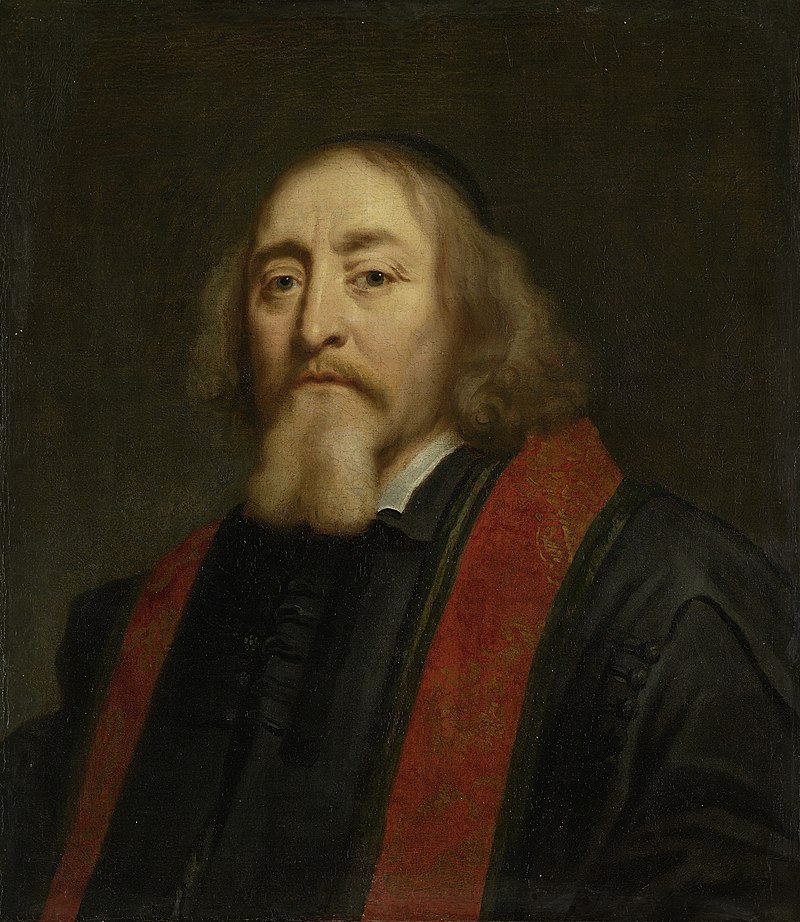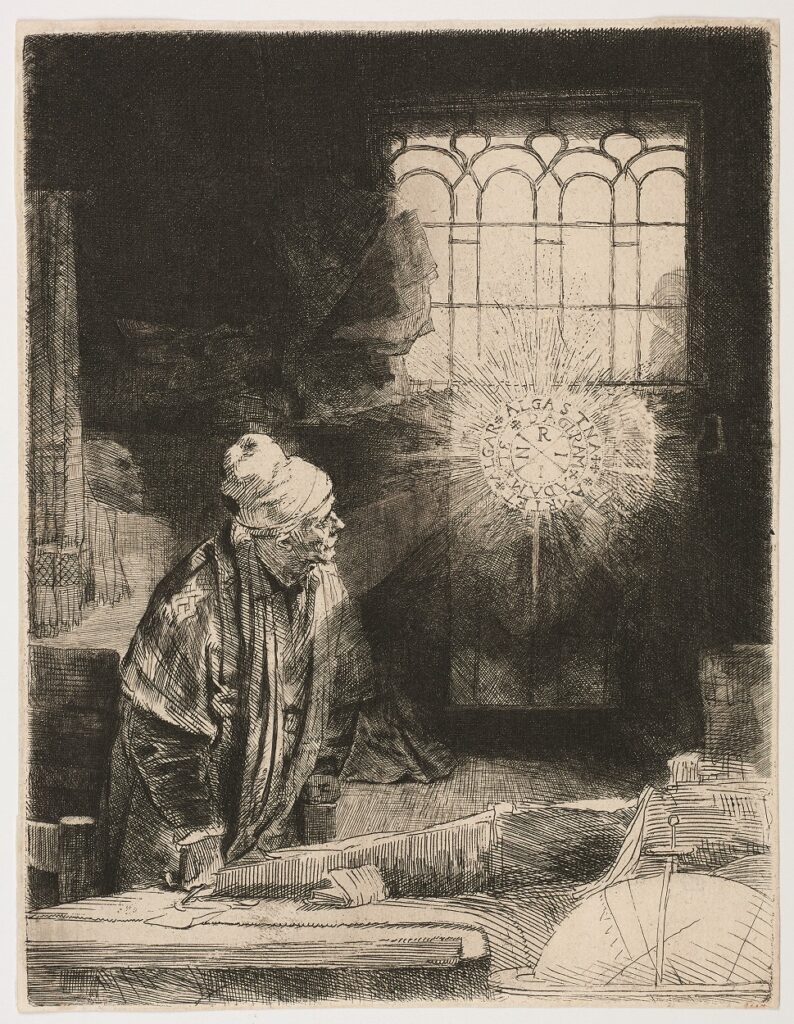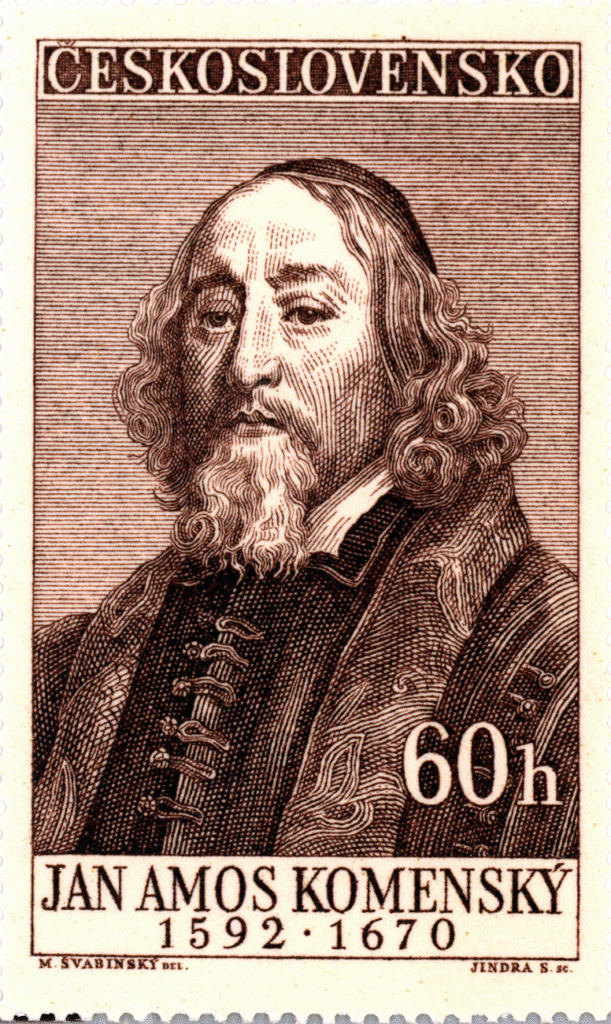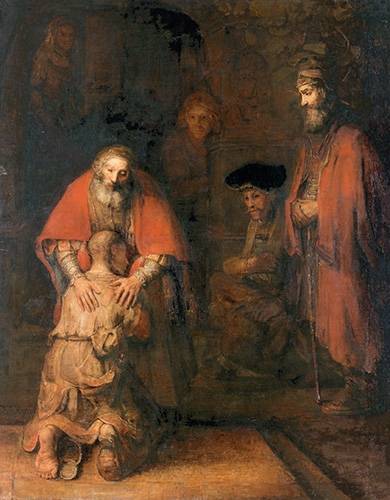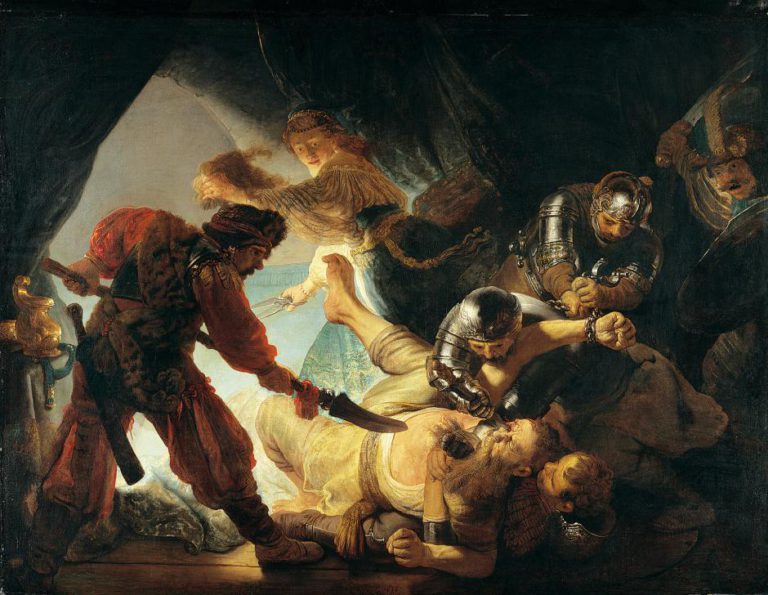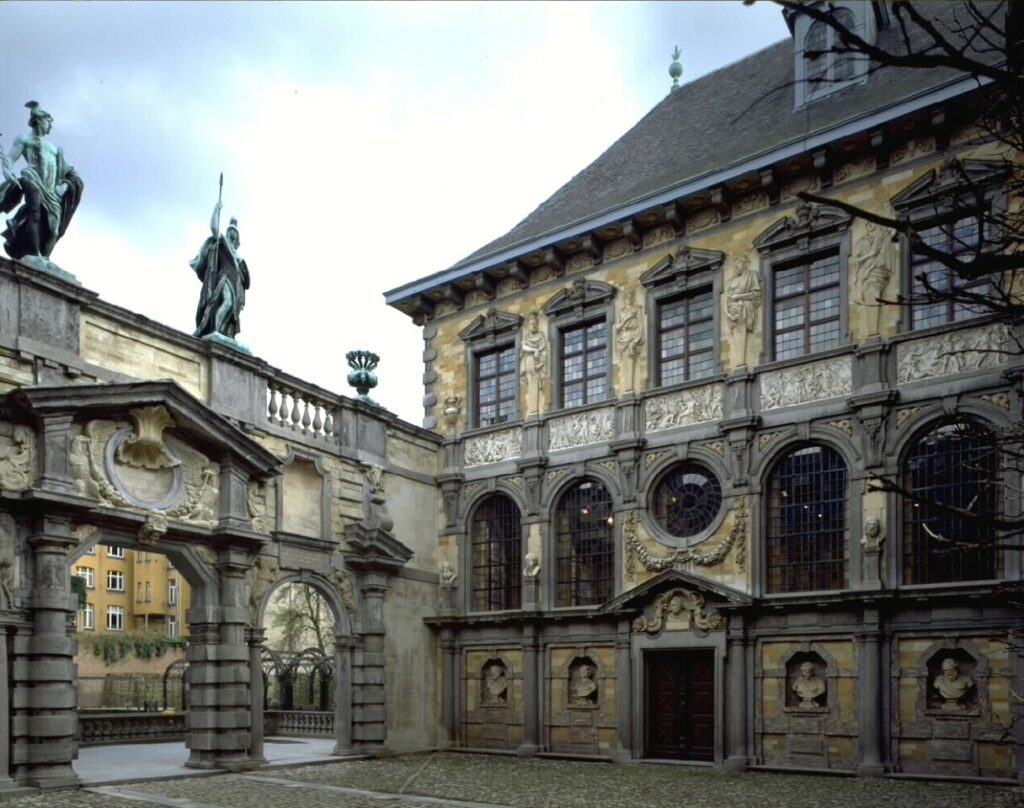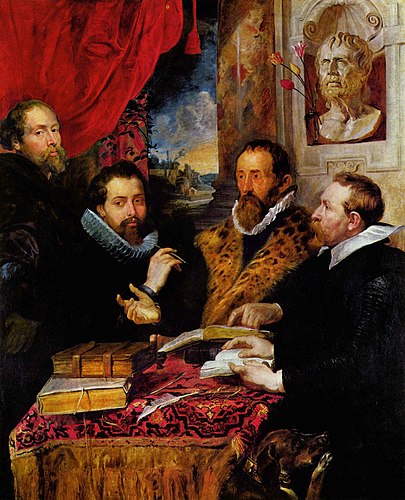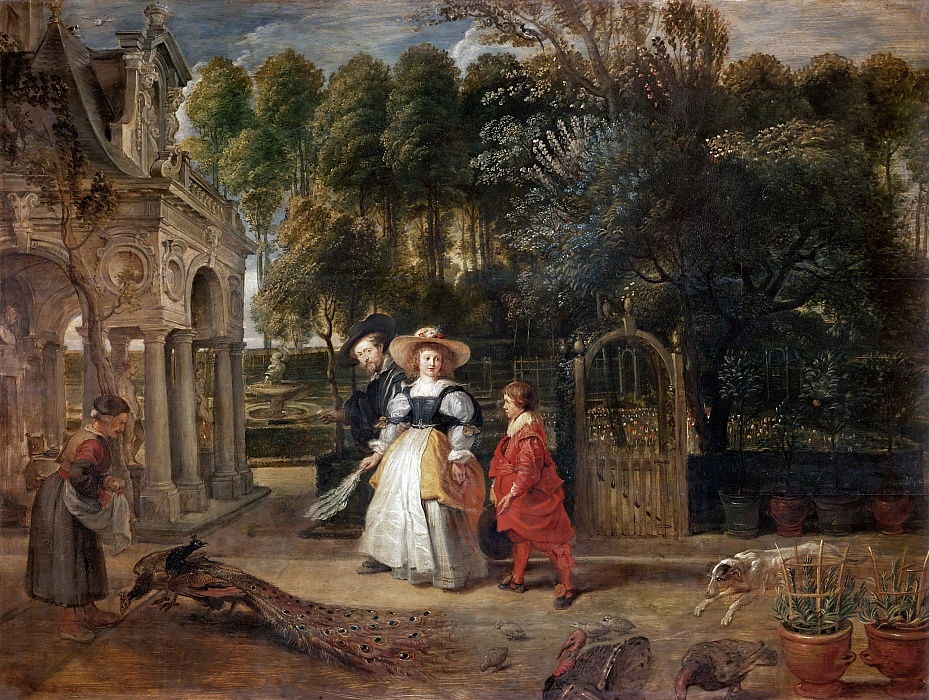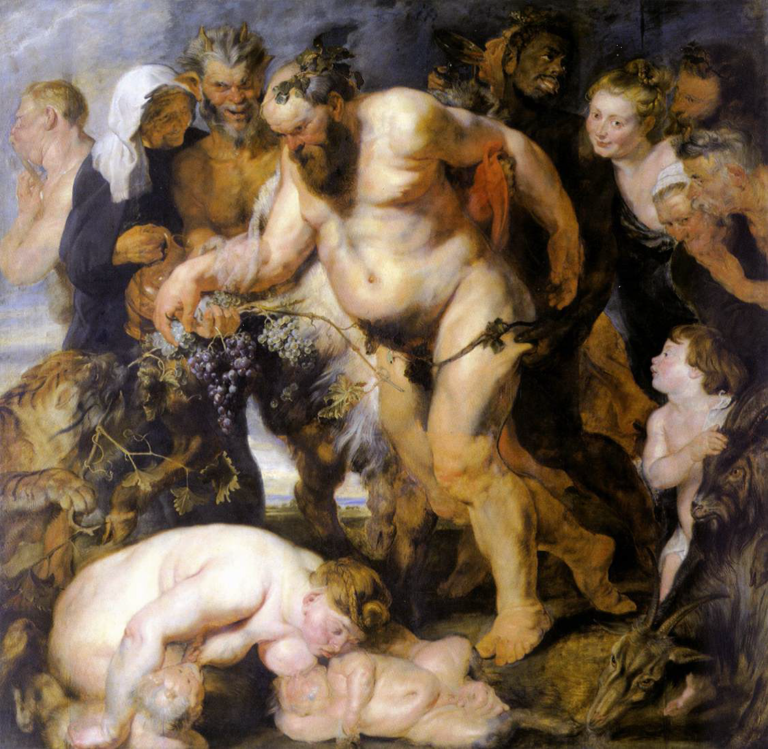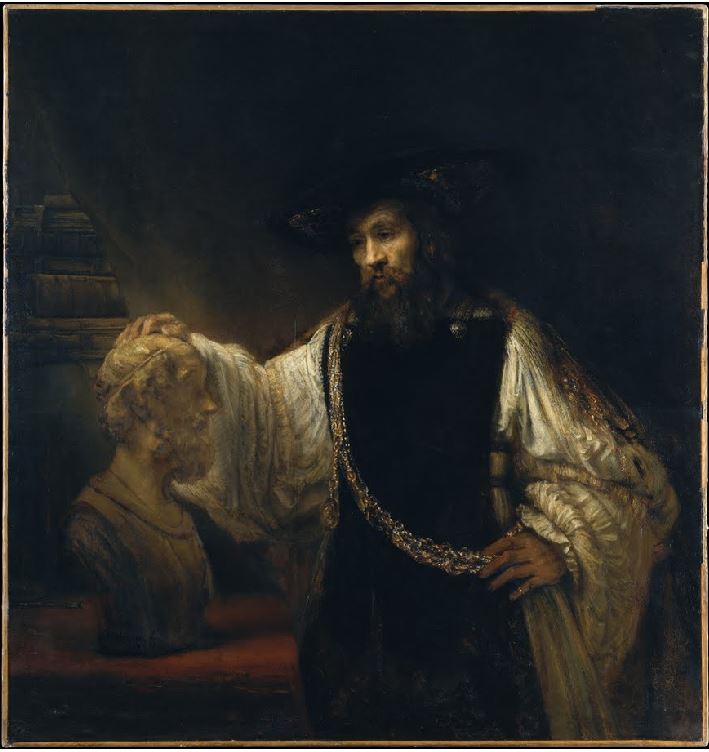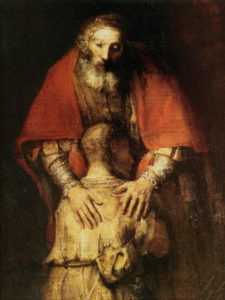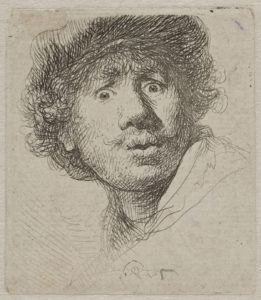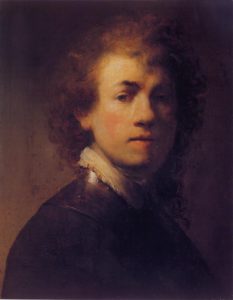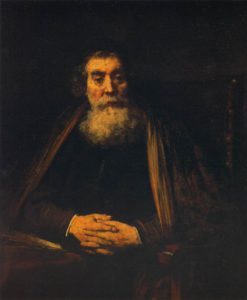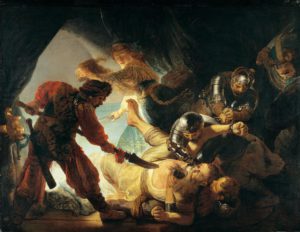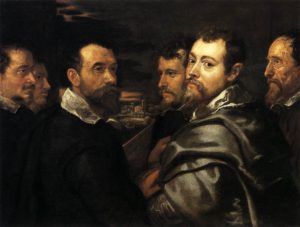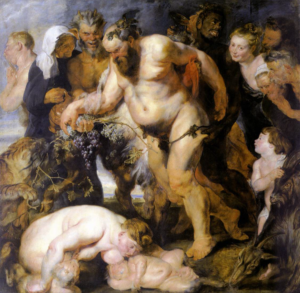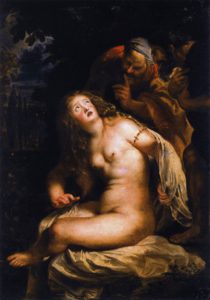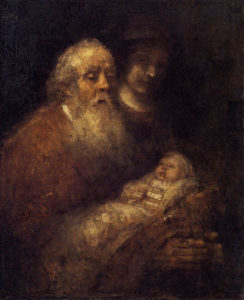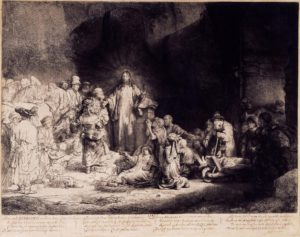English version of this article: Rembrandt light of Agapè
Rembrandt Harmenszoon van Rijn. Ne comptez pas sur nous pour vous raconter ici sa vie en quelques lignes ! 1
De prime abord il semble que depuis l’époque romantique, tout, et presque trop, ait été dit et écrit au sujet de ce maître hollandais de la lumière, tombé dans l’obscurité par un néoclassicisme à la dérive.
La tâche qui nous incombe est donc celle d’un Appelle, ce peintre grec qui, mis au défi, s’appliqua à peindre une ligne encore plus fine sur la très fine ligne peinte par son rival. Pour tracer cette ligne, nous dessinerons les horizons de la bataille politique et philosophique de l’époque afin de mettre en lumière trois aspects généralement ignorés permettant de jeter un regard inattendu sur la démarche de notre peintre-philosophe.
Tout d’abord, nous allons montrer que Rembrandt (1606-1669) est un peintre de la « Guerre de Trente Ans » (1618-1648), qui se déroule pendant une partie importante de sa vie et définira son engagement politique, philosophique et religieux en faveur de la paix et de l’unité.
Ensuite, nous chercherons à identifier l’origine de cette vision du monde. Rembrandt a-t-il connu l’œuvre et la personne de l’humaniste tchèque Jan Amos Komensky (Comenius) (1592-1670), un des acteurs politiques impliqué dans la révolte de la Bohème. Ce militant pour la paix, précurseur de Leibniz, se rend souvent aux Pays-Bas et s’installe définitivement à Amsterdam en 1656.
De fait, une forte communion d’idées unit le peintre et ce grand pédagogue morave. Aussi, n’est-il pas étonnant que les Traités de Westphalie, qui mirent fin à cette guerre, soient basés sur cette notion de repentir et de pardon si cher à Comenius que Rembrandt évoquera sublimement dans sa peinture.
Enfin, nous comparerons la vie et l’œuvre de Rembrandt à celle d’un peintre du parti de la guerre : Pierre-Paul Rubens (1577-1640). Rembrandt, allergique à toute quête de gloire terrestre, ne pouvait qu’inscrire son œuvre en faux contre celle de ce peintre-courtisan flamand à la mode qui mobilisa tout sa virtuosité au service de la croisade de la Contre-Réforme et le fanatisme conquérant des Jésuites de cette époque.
Ainsi, ce que Rembrandt affirmait au sujet de ses tableaux s’applique aussi pour une vue sur sa vie : le nez collé sur la toile, les odeurs toxiques nous irritent le nez et nos yeux picotent, mais avec un peu de recul, une beauté sublime nous envahit pour rester gravée en nous pour toujours.
Quel art ?
Depuis le triomphe de la thèse moderniste d’Emmanuel Kant , la Critique de la faculté de juger, il n’est pas « politiquement correct » d’affirmer que l’art possède une dimension politique. Et pour cause ! Si l’art peut infléchir le cours de l’histoire et la façonner par son pouvoir, c’est qu’il est vecteur d’idées ! Une impossibilité selon la thèse Kantienne, car l’art est un acte gratuit, libre de tout, y compris de sens. Voilà l’ultime liberté ! On aime où on n’aime pas, c’est uniquement une question de goût.
Reprenant ici le flambeau du poète allemand Friedrich Schiller, nous nous efforcerons de vous convaincre du contraire et d’abolir la tyrannie du goût. Pour nous, l’art est un acte éminemment politique, bien que l’œuvre d’art n’ait rien de commun avec un simple manifeste politique et que l’on ne puisse aucunement réduire l’artiste à un « activiste » ordinaire. Son domaine, celui du poète, du musicien ou de l’artiste plastique, c’est d’être un guide pour les hommes. Leur permettre d’identifier en eux ce qui les rend humain, c’est-à-dire conforter cette parcelle d’âme, de créativité divine qui les place entièrement au zénith de leur responsabilité pour la création toute entière. Pour y parvenir, et nous le développerons ici, ce qui compte dans l’art c’est quelle conception d’amour il communique. En rendant sensible un universel, un art sublime rend accessible les plus hautes conceptions d’amour. Cet art là, celui qui nous fait réfléchir, mobilisera surtout des énigmes, des ambiguïtés et des ironies pour nous faire accéder à l’idée située au-delà du visible. Car un art se limitant à la théâtralité et à la beauté des formes, sombre dans un amour érotique et romantique, privant l’homme de son humanité et donc de son pouvoir révolutionnaire.
Rubens est l’ambassadeur virtuose de grandes impuissances de son époque : la gloire de l’empire et le pouvoir de l’argent incarné par « la bulle des tulipes ». En bref, l’oligarchie. Rembrandt, lui, est l’ambassadeur des dépossédés : les faibles, les malades, les humiliés, les réfugiés, en bref il sera à l’image du Christ un ambassadeur de l’humanité.
Il peut sembler bizarre de qualifier Rembrandt de « peintre de la guerre de trente ans ». Mais c’est peut-être seulement face à de très grands défis que l’homme trouve en lui-même la motivation et les ressources pour mobiliser son génie. Bien que Henry Kissinger et Javier Solana veuillent nous faire entrer dans une ère « post-Westphalienne », nous ferons tout pour empêcher leur« Nouvelle guerre de trente ans ». Rembrandt sera une de nos armes.
Le contexte historique
Avant d’aborder l’œuvre de Rembrandt, il est indispensable de connaître les enjeux de la « Guerre de trente ans ». Ce nom fait référence au dernier épisode d’une longue période de « Guerres de religion » qui embrasèrent l’ensemble du monde au seizième siècle, bien que le conflit se soit principalement déroulé en Europe centrale et en Allemagne. La révolte de la Bohème en 1618 en marque le début et la paix de Westphalie, en 1648, la fin. C’est une guerre qui, au-delà des enjeux religieux, marque surtout la fin de l’utopie impériale des Habsbourg et la naissance de l’Europe moderne.
Les traités de Westphalie :
une révolution du droit international
Les traités de Westphalie, signés en 1648, et les accords de paix séparés entre la France et les Pays-Bas avec l’Espagne mettront en pièces le fondement juridique d’empire. Comme l’avaient déjà souhaité Henri IV et Sully avec leur concept de « Grand Dessein », l’Etat-nation souverain deviendra la plus haute autorité du droit international. Si l’Etat-nation devient la base de l’ordre juridique, alors les petits pays obtiendront les mêmes droits que les grands et la notion de grand = fort, et petit = faible s’estompera. Plutôt qu’une relation dominant/dominé, la coopération d’Etat à Etat devient la règle de la vie politique internationale. La République suisse est ainsi reconnue et les Pays-Bas, en guerre depuis presque quatre-vingt ans pour leur indépendance sont reconnu par l’Espagne suite à la Paix de Westphalie.
Ensuite, et c’est sans doute l’aspect le plus révolutionnaire des accords, l’essence même de la paix est constituée par le pardon mutuel.
Le paragraphe II des accords stipule explicitement que : « Il y aura d’une part et d’autre, un état d’oubli perpétuel, une amnistie, et un pardon de tout ce qui a été commis depuis le début de ces troubles, peu importe dans quel endroit ou de quelle façon ces hostilités ont été commises ; de telle façon que personne, sous aucun prétexte quelconque, ne commettra des actes d’hostilité, entretiendra l’inimitié ou provoquera des troubles aux autres ».
Plusieurs paragraphes (XIII, XXXV, XXXVII, etc.) stipulent (sauf quelques exceptions) l’annulation générale des dettes et des engagements financiers créateurs d’une logique de revanche perpétuelle : « Que les dettes liées à des achats, des ventes, des revenus ou peu importe leurs noms, qu’ils soient extorqués par la violence par une des parties de la guerre, et si les créditeurs montrent et prouvent qu’un versement a réellement eu lieu, cette dette ne sera plus redevable, avant que ces transactions soient ajustées. Les créditeurs seront obligés de formuler leurs exigences dans une période de deux ans suite à la déclaration de la paix, sous peine d’être condamné au silence perpétuel. » (Paragraphe XXXIX).
Ceux qui ont pratiqué l’usure sont également pardonnés !
En réalité, la paix de Westphalie représente la naissance d’un nouvel ordre politique fondé sur la mise en règlement judiciaire de l’ensemble du système financier impérial en faillite. C’est un de ces rares moments où le futur a déterminé le présent. Pour l’obtention d’un bien plus grand défini, éclairé par l’intérêt général, on renonce à quelques petits avantages mesquins immédiats. Tous sont perdants et gagnants au même titre, car il n’y ni vainqueur, ni vaincu. Cet ordre de co-développement pacifique va de pair avec une « tolérance » religieuse à l’intérieur de chaque Etat-nation. Catholicisme, luthéranisme et calvinisme se trouvaient finalement sur un pied d’égalité œcuménique.
Pour saisir l’origine de ces guerres, il faut remonter au début du seizième siècle. Lors du Concile de Trente (1545-1563) l’église Catholique romaine avait écarté d’une main les réformes préconisées par Erasme de Rotterdam pour mettre fin aux troubles. Comme il l’avait prédit, Rome, en choisissant comme adversaire principal le démagogue radical et impuissant Luther, s’enfonçait dans un dogmatisme stérile et intolérant permettant chaque jour à la Réforme de gagner du terrain.
Bien que la paix d’Augsbourg de 1555 ait réussi à calmer temporairement la situation, les dispositions ambiguës de ce traité portaient en germe les conflits futurs. Tout d’abord, la paix ne s’applique qu’aux catholiques et aux luthériens. Les Jésuites se feront un malin plaisir de jouer la division dans le camp des réformés en dressant les luthériens contre les calvinistes. Ainsi en Allemagne, ils prétendent tout simplement que le calvinisme est interdit parce que non expressément cité dans l’accord.
Ensuite, les peuples n’obtiennent pas de réelle liberté confessionnelle, car les sujets doivent adopter la confession de leur seigneur, qui lui, a la liberté de choix (cujus regio, ejus religio). Pour se défendre, les princes protestants se réunissent dès 1608 sous la direction de l’électeur palatin Frédéric V pour former « l’Union évangélique ». Ils placent leur espoir en la France d’Henry IV, pays où l’Edit de Nantes de 1598 a mis fin aux guerres de religion. Suite à l’assassinat du roi en 1610, ils s’allient avec la Suède et l’Angleterre. Côté catholique, Maximilien de Bavière constitue dès 1609 une Sainte Ligue avec le soutien de l’Espagne.
Au-delà des étiquettes religieuses et politiques des deux camps, on peut identifier un véritable parti de la guerre de chaque coté. Les nuées qui portent l’orage jettent l’ombre de la guerre sur une Europe coupée en deux.
La révolte de la Bohème
Ainsi, après l’interminable révolte des Pays-Bas, l’insurrection de la Bohème fait craindre le pire aux Habsbourg, car si elle devient une deuxième Hollande, d’autres pays, comme par exemple la Pologne, pourraient basculer dans le camp de la réforme et porter atteinte à l’équilibre géopolitique impérial.
Depuis 1576, la couronne de Bohème appartient à Rudolf II, qui bien qu’ayant un penchant pour l’ésotérisme, sera le protecteur de Tycho Brahé et de Johannes Kepler, à Prague. En 1609, les protestants de Bohème arrachent à ce monarque catholique une « lettre de majesté » qui leur accorde certains droits en matière de religion. Après sa mort en 1612, son frère Matthias laisse la direction du pays à Kleszl, l’un des cardinaux de la Contre-Réforme qui en refuse l’application.
C’est ainsi que se produisit la fameuse « défenestration de Prague » résultant d’une négociation très chaude qui vit les protestants jeter les deux représentants impériaux par la fenêtre, lesquels atterrirent sur un tas de fumier. Ce fut le signal d’une révolte générale et suite à la mort de Matthias, les insurgés prirent comme souverain, l’électeur palatin Frédéric V, plutôt que d’accepter le choix des Habsbourg. Un noble protestant, Charles de Zerotin et un pasteur morave, Jan Amos Komensky « Comenius » étaient les éminences grises de cette révolte, comme le montre notamment le fait que Frédéric V soit couronné en 1619 par Jan Cyrill, confesseur de Zerotin dont Comenius épousera la fille. (Encadré 2)
Comenius :
enseigner tout à tous et toutes
Jan Amos Komensky (Comenius) (1592-1670) était avant tout un homme de terrain et un inspirateur pour le bien. Un an après sa mort, en 1670, Leibniz écrivait « il viendra le temps, Komensky, où les honneurs seront rendus à tes œuvres, à tes espoirs, et même aux objets de tes désirs ».
Comenius est en effet un des précurseurs de Leibniz. Tout d’abord il s’oppose à la pétrification de la pensée de son époque résultant de l’hégémonie de l’aristotélisme : « Peu après cette union du Christ et d’Aristote, l’Eglise connut un état affligeant et se remplit du vacarme des querelles théologiques. »
Défenseur ardant de la notion de libre-arbitre qu’il ne voit pas s’opposer à une certaine prédestination bien comprise, il se sent plus proche de la démarche de Jan Hus que celle de Calvin, bien qu’on le range généralement dans le rang des calvinistes.
Pour lui, comme pour Leibniz, une physique sans métaphysique se condamne à la stérilité. Grâce à cette inclusion de la transcendance, il ne conçoit plus la nature comme un simple agrégat défini par un système de lois (vision qu’il reprochera violemment à Bacon, Galilée et Descartes), mais comme un processus dynamique et comme un devenir. Ce devenir n’est pas répétition éternelle du même, mais progression et potentialisation : il y a dans la nature une tendance au développement qui est en même temps une tendance vers l’accomplissement et l’harmonie.
En 1608, Comenius fait son entrée à l’école latine de Prérov (Moravie), école réorganisée à la demande de Charles de Zerotin sur le modèle de l’école calviniste de Sankt Gall en Suisse. Zerotin est une des figures clefs de la noblesse de Bohème, zélateur de la petite Eglise de l’Unité des Frères, organisateur de l’enseignement populaire et éminence grise de la résistance anti-Habsbourg à l’échelle internationale. Il prête, par exemple, une forte somme d’argent à Henri IV en 1589 et le rencontre devant Rouen en 1593. La conversion de Henri IV au catholicisme (« Paris vaut bien une messe ! ») ruine tous les espoirs de Zerotin pour rapprocher les frères de l’Unité avec les Huguenots français.
Ami de Théodore de Bèze (Bezius), le futur confesseur de Jeanne d’Albret, qu’il fréquente lors de ses études à Bâle et Genève, Zerotin envoie Comenius étudier à l’Université de Herborn, dans le Nassau. Cette université fut fondée en 1584 par Louis de Nassau, frère de Guillaume le Taciturne, l’organisateur de la révolte des Pays-Bas contre l’Espagne. Louis de Nassau était en contact suivi avec le dirigeant huguenot français Gaspard de Coligny et avec Walsingham, le chancelier d’Elisabeth I, en Angleterre ; c’est-à-dire au centre de la conspiration anti-Habsbourg. Instigateur avec Zerotin de la révolte de la Bohème et après une brève période chez les maquisards, pour lesquels il dessine une carte de Moravie, Comenius s’exile, à la tête de son église, « l’Unité des Frères de Bohème ».
Jusqu’à sa mort il est l’âme de la résistance bohème, gardien de la langue tchèque et tête pensante de la diaspora.
Pour lui, les guerres ne sont possibles que si une vaste majorité de la population sombre dans l’ignorance. A l’opposé du système jésuite qui réserve l’éducation aux élites, Comenius, partant de la conviction que chaque homme est créé à l’image de Dieu, imagine une éducation de très haut niveau, accessible à tous, qu’il élabore dans La Grande Didactique (1638). Suivant les préceptes d’Erasme et de Vivés, Comenius abolit les punitions corporelles et établit la mixité des classes. Des écoles gratuites s’installent dans chaque village et deviennent de véritables ateliers prototypes des Ecoles Polytechniques et des Arts et Métiers, portées par une véritable joie de la découverte.
Le réseau international d’académie des sciences de Leibniz trouve son origine dans les groupes d’amis de Comenius. Véritable fondateur de la pédagogie moderne, il est un des premiers à comprendre que l’enfant est un être de sensibilité avant d’être un être de raison.
Jusque là, l’ignorance était souvent vu comme une manifestation du diable. Le cardinal français Pierre de Bérulle (1575-1629), pourtant fondateur de la Congrégation de l’Oratoire, écrivait par exemple que « l’enfance est l’état le plus vil et le plus abject de la nature humaine après celui de la mort ».
Pour rendre la connaissance accessible à chacun, quelle que soit son origine sociale, sa race, son sexe ou sa religion, Comenius révolutionne les a priori de la pensée éducative.
Ainsi, dans de belles salles de classe, bien tenues et remplies d’images et de cartes, on donne des cours de moins d’une heure, couvrant tous les domaines que l’on trouve autour de Comenius dans la gravure qui illustre l’édition latine de ses œuvres complètes : travaux manuels, musique, astronomie, géométrie, botanique, imprimerie, construction, peinture et sculpture.
Bien que Comenius enseigne lui-même le latin, il pense qu’avant tout chaque élève doit maîtriser sa langue maternelle. Car jusque là, l’enseignement du latin se fait en latin, temps pis pour ceux qui ne comprennent rien ! Il introduit aussi des manuels scolaires illustrés (Le Monde Sensible en images, 1653), stupidement banni de l’éducation pour « ne pas inviter les sens à venir troubler la pensée ». Pour Comenius, l’image accompli la même fonction qu’un télescope qui amène dans le champ de la perception ce qui est naturellement situé hors de ses limites.
Ses idées, et les résultats des écoles qui s’inspiraient de cette démarche séduisirent toute l’Europe, et plus encore. Vers 1642, Comenius est embauché par Johan Skytte (1577-1645), l’influent chancelier de l’Université d’Uppsala pour mettre en œuvre son nouveau système d’éducation en Suède. Skytte, un érudit inspiré par Platon et Erasme, sera le tuteur du roi Gustave Adolphe et son fils Bengt Skytte sera l’un des précepteurs de Leibniz.
Avant cette offre, Comenius avait déjà écarté une proposition que Richelieu formula peu avant sa mort pour qu’il se mette à l’œuvre en France, et une autre provenant d’Amérique de la part de John Winthrop (junior) pour diriger l’Université d’Harvard, nouvellement fondée dans la Massachusetts Bay Colony de Cotton Mather. Si Comenius opte alors pour la Suède, c’est qu’il cultive l’espoir qu’un jour la Bohème sera libérée de l’occupant habsbourgeois, avec l’aide de ce pays.
Les insurgés furent défaits à la bataille de Montagne Blanche en 1620 par une coalition catholique, composée des troupes espagnoles de retour des Flandres et des Bavarois de Maximilien. Avec eux, René Descartes, venu sur ses propres frais, entra dans Prague à la recherche des instruments astronomiques de Kepler. 2
Comenius, l’un des premiers à être proscrit et sous le coup d’un mandat d’arrestation, et Zerotin, échappent à la répression. Tous les résistants sont arrêtés et certains décapités sur la place publique.
On installe leur tête sur des piques pour les exposer sur le pont Saint Charles. Parmi eux, le recteur de l’Université de Prague, Jan Jessenius, auteur de la première dissection publique dans cette même ville en 1600 et ami de l’astronome danois Tycho Brahé. Comme avertissement à ceux qui se servent de discours pour encourager les hérésies, on lui arrache la langue avant de le décapiter, de l’écarteler et de l’empaler. Trente mille personnes s’exilent et Frédéric V, « le roi d’hiver », et sa cour trouverons refuge à la Haye, aux Pays-Bas, là où Comenius l’a rencontré lors du retour de ses noces avec Elisabeth Stuart en Angleterre en 1613, noces pour lesquelles Shakespeare avait fait jouer La Tempête.
Une guerre mondiale
1618 marque l’embrasement général du continent européen. La volonté affichée et la poussée politique et militaire des Habsbourg pour unifier l’ensemble du continent derrière un seul empereur et sous la bannière d’une seule religion, déclenchent une guerre générale. Dès 1625, avec des subsides anglais et français, le Danemark de Christian IV, puis la Suède de Gustave Adolphe interviennent par le nord contre les Habsbourg en Allemagne. La France ouvre elle-même un autre front à l’ouest en 1635. Richelieu, qui avait défait les huguenots à La Rochelle en 1628 (car il « combattait leurs droits politiques, mais non leurs droits religieux ») les soutient activement hors du territoire français, car il estime qu’ « il est certain que si le parti protestant est tout à fait ruiné, l’effort de la maison d’Autriche retombera sur la France ».
En 1633, Les Misères et malheurs de la guerre, célèbre série de gravures du lorrain Jacques Callot donnent une bonne idée de cette guerre, qui, avec son cortège de misère, de famines, d’épidémies et de désolation, ravage l’Europe. On estime qu’au niveau de la superficie de l’Allemagne d’aujourd’hui, la population passa d’environ 15 millions à moins de 10 millions d’âmes.
Des centaines de villes furent réduites à de simples villages et des milliers de bourgades furent tout simplement effacées de la carte. La guerre se répercuta dans l’ensemble des colonies des puissances engagées dans le conflit. Les pirates anglais et hollandais n’hésitaient pas à en découdre avec les vaisseaux espagnols et portugais à l’autre bout du globe. Concernant l’Espagne, fidèle pilier des Habsbourg, 250 millions de ducats furent utilisés dans les dépenses de guerre (entre 1568 et 1654), malgré une faillite d’Etat en 1575. Cette somme représente le double des revenus provenant du nouveau monde (or, épices, esclaves, etc.) qui se chiffraient à 121 millions de ducats !
Rembrandt et Comenius
Que Rembrandt soit interpellé par la situation de guerre générale qui bouleverse toute l’Europe ressort déjà fortement dans l’un de ses premiers autoportraits [FIG1].
Il se peint, jeune homme partagé entre deux choix. Une épaule sous un fragment d’armure fait ressortir l’appel aux armes pour les hommes de son âge, en particulier après l’attaque des troupes espagnoles sur Amersfoort en août 1629.
L’autre épaule est nonchalamment caressée par une liefdelok (une cadenette), cette longue mèche de cheveux que se laissaient pousser les jeunes amoureux. Que choisir ? L’amour de la patrie ou l’amour pour sa bien-aimée ?
De plus en plus souvent fâché avec Constantin Huygens, le puissant secrétaire du stadhouder qui l’a fait venir à Amsterdam, sa pensée s’approfondit et son activité se densifie.
Dix ans plus tard, la mort de Saskia, en 1642, année de La ronde de nuit, le plonge dans une crise, et petit à petit, il abandonne ses autoportraits où on le voit souvent tel un courtisan « à l’italienne », gant à la main et chaîne en or pour affirmer son statut social à la Cour. Tout l’or du monde ne permet pas de racheter la vie de ceux qui nous sont chers.
Rembrandt, affirmant qu’il n’a pas besoin de faire le traditionnel voyage en Italie car on trouve toute l’Italie sur le marché d’art d’Amsterdam, nous laisse subitement des dessins montrant les portes de Londres au début des années 1640, alors que Comenius y est en voyage, et qu’un ami de Rembrandt, le rabbin Menessah Ben Israel, tuteur de Spinoza, tente de négocier l’entrée des juifs en Angleterre.
De timides hypothèses concernant l’influence de Comenius sur Rembrandt existent, cependant, une recherche approfondie pourrait nous livrer des perles.
Bien que Rembrandt évolue dans l’environnement de la communauté Mennonite, des anabaptistes pacifiques bien loin d’un quelconque engagement politique, son engagement pour « la cause Bohème » nous semble se manifester de la façon la plus convaincante dans La Conspiration nocturne de Claudius Civilis dans le Schakerbos [FIG2].
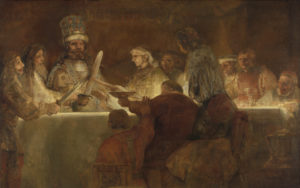
Fig. 2 : Rembrandt, La conspiration de Claudius Civilis dans le Schakerbos, 1661-62, Nationalmuseum, Stockholm.
Prévu dans un ensemble de plusieurs tableaux destinés au nouvel Hôtel de Ville d’Amsterdam, la série célèbre la révolte des Bataves face aux romains. Sur la base des écrits de Tacite, cette histoire est distillée au service du patriotisme néerlandais, et le parallèle entre les romains et l’Espagne est évident. Pour des raisons peu connues, le tableau de Rembrandt fut retiré assez rapidement après son acceptation. Pour dénoncer la lâcheté des dirigeants, Rembrandt semble avoir transposé cette scène à son époque. Un historien suédois pense que le dirigeant de la conspiration n’est pas Claudius Civilis, général qui avait perdu un œil dans la guerre, mais un autre général qui perdit également un œil en situation de guerre, le général « hussite » Zirka !3
Rappelons que Comenius et la révolte de Bohème s’inspiraient de Jan Hus. Le Claudius Civilis de Rembrandt se présente effectivement avec des habits d’Europe centrale. De gauche à droite on voit d’abord un patricien hollandais. S’agit-il du républicain Jan de Wit ?
On voit ensuite un moine, sans arme, posant sa main sur celle de Claudius. S’agit-il de l’Eglise des Frères de Bohème de Comenius ? Selon les historiens, les deux calices, un large, l’autre étroit, peuvent représenter la communion sous les deux espèces, l’une des revendications de Jan Hus. On voit aussi un rabbin qui participe au complot. Bizarre, tout cela pour de simples bataves !
Que les notables d’Amsterdam soient mécontents de voir leur idole historique figurée comme un géant cyclope est probable. Qu’ils soient interpellés sur leur indifférence pour la cause Bohème, est autre chose.
Comenius arrive à Amsterdam, sur invitation de la famille de Geer, en août 1656, année de la mise en banqueroute de Rembrandt.4
Louis de Geer, surnommé « roi de l’acier » ou « Fugger du Nord » et son fils Laurent seront les mécènes à vie de Comenius dont ils paieront l’enterrement et pour lequel ils feront construire une chapelle à Naarden. Cette famille calviniste intransigeante, originaire de Liège, en Belgique, mais installée à Amsterdam, mettra sur pied l’ensemble des industries du fer et du cuivre suédois. Elle fera venir trois cents familles wallonnes qui travaillaient à la manière hollandaise, et pour lesquelles elle fit construire hôpitaux, écoles, lotissements et magasins. En Angleterre, De Geer finançait également John Dury et Samuel Hartlib, deux amis actifs de Comenius. En guerre contre la Royal Society et Francis Bacon, Hartlib voulait rendre les connaissances scientifiques accessibles à l’ensemble de la population. C’est à Hartlib que John Milton dédia son traité « De l’éducation ».
Louis de Geer et Skytte inviteront Comenius à travailler pour la Suède, jugeant ses réformes de l’éducation un excellent investissement permettant d’accroître le travail productif de l’économie physique. Ces liens avec la famille de Geer nous conduisent à Rembrandt, car la sœur de Louis de Geer, Margareta était, elle, marié avec Jacob Trip, également actionnaire des mines de cuivre en Suède, et ce couple installé à Dordrecht se fera portraiturer par Rembrandt, lui fournissant ainsi une commande bien rémunérée pendant des années difficiles.
La ville d’Amsterdam octroya une pension annuelle à Comenius, l’incitant à publier l’ensemble de son œuvre pédagogique, et lui confia la clef de la bibliothèque de la ville. Il fera aménager sa famille et ses assistants et installera une bibliothèque et une imprimerie derrière la Westerkerk, l’église où Rembrandt est enterré. En allant chaque jour de son domicile à son imprimerie, Comenius croisait ainsi la rue où Rembrandt vivait ses derniers jours.
Depuis le début du vingtième siècle, les conservateurs tchèques estiment que le Portrait d’un vieillard au musée des Offices de Florence [FIG3] est en réalité un portrait de Comenius.5
Rappelons que Rembrandt exigeait de chacun de ses modèles quatre heures de pose pendant au moins trois mois, exercice assez difficile pour un Comenius âgé. Ce qui est certain, c’est qu’un des élèves de Rembrandt, Juriaen Ovens, a peint le portrait de Comenius à cette époque.
La paix de Westphalie et la Via Lucis
Bien que la Bohème n’ait pas obtenu pas son indépendance lors de la Paix de Westphalie, on ne peut pas sous-estimer l’influence de Comenius sur les négociations qui aboutirent aux accords de paix. La Cesta Pokoje (Chemin vers la paix) de 1630, un premier écrit en tchèque est décrit comme « un écrit éthico-religieux dans lequel l’amour, la foi et la compréhension mutuelle sont posés comme les seul fondements éthiques d’une paix possible ». De 1641 à 1642, immédiatement avant les pourparlers de paix, Comenius écrivit la Via Lucis, (la Voie de la lumière), qui a pu servir de mémorandum aux négociateurs.
Cette « voie de la lumière » était-elle un mysticisme millénariste, comme on l’a souvent prétendu ? Lorsqu’on demanda à Comenius quelle espérance attendre et quand adviendrait un changement majeur, il répondit que l’espérance consistait en la venu d’un temps où le Gospel du Royaume serait prêché dans le monde entier et une paix universelle établie. Ce changement qu’on peut espérer résultera d’une lumière vers laquelle seront tournés non seulement les yeux des chrétiens, mais ceux du monde entier. Elle « proviendra de la combinaison des lanternes de la conscience humaine, d’une considération rationnelle des œuvres de Dieu ou de la nature, et de la loi, ou volonté, divine ». Pour lui, « l’entreprise humaine peut, à travers la prière et les considérations d’hommes pieux imaginer les voies possibles pour réunir ces rayons, les faire irradier sur toute l’espèce humaine et répandre des pensées similaires dans les esprits des autres ».6
C’est bien ce concept que l’on retrouve dans l’eau-forte de Rembrandt, utilisé maladroitement par Goethe qui le copia comme frontispice pour son Fausten 1790.7
Loin d’être un homme qui scelle un pacte avec le diable, le sujet de la gravure est la lumière (miroir du Christ) éclairant la vie et l’esprit des hommes. Bien avant Voltaire et les « lumières », Comenius et Rembrandt avaient investit la métaphore de la lumière.
Pour se faire une idée de la démarche pacificatrice de Comenius, on peut lire un autre mémorandum : Angelus Pacis,(l’Ange de la Paix) « envoyé aux ambassadeurs de paix anglais et hollandais à Breda pour être de là envoyé à tous les chrétiens de l’Europe et ensuite à toutes les nations du monde entier afin qu’elles s’arrêtent, qu’elles cessent de se battre ». Comenius constate laconiquement que les deux pays ne se battent même plus sous un prétexte religieux, mais ouvertement pour des possessions matérielles ! Pour s’en sortir, il leur propose une nouvelle amitié :
« Mais de quelle manière inaugurez-vous cette amitié nouvelle (ou plutôt ce rétablissement de votre amitié) ? Ne sera-ce pas par le pardon général que vous vous accorderez les uns aux autres ? Les sages ont toujours regardé l’oubli des injures reçues comme le plus sûr chemin menant à la paix. Toucher trop rudement les blessures, c’est raviver la douleur et fournir à la blessure elle-même une occasion de s’irriter. Que si cela est vrai, il faut souhaiter que la rivière d’Aa, dont les eaux très paisibles arrosent Breda, se changeât pour l’heure en ce fleuve de Léthé dont les poètes nous ont conté que quiconque y buvait, oubliait tout le passé. Celui qui a été fauteur de troubles, Dieu le trouvera, même si par amour de la paix les hommes le ménagent. Que le juste commence par s’accuser lui-même ; cela veut dire que celui que sa conscience accuse d’avoir rompu l’amitié et témoigné de l’inimitié devra selon la justice être le premier et le plus ardent à rétablir l’amitié. Si la partie offensante néglige ce devoir de justice, ce sera à la louange de la partie de l’offensé d’assumer ce rôle d’honneur, selon le mot du philosophe. »8
Rembrandt et le pardon
Exprimer ce moment où l’amour amène le pardon sera précisément un des sujets chers à Rembrandt. Ce n’est probablement pas un hasard s’il nomma son fils Titus, car à l’époque on croyait que l’empereur romain Titus avait montré une grande clémence envers les chrétiens. Rembrandt était également fasciné par la figure de Saint-Paul, personnage qui, par sa conversion, a montré la transformation possible de chaque humain en homme de bien. L’autoportrait comme Saint-Paul du Rijksmuseum [FIG. 4], où l’on voit Rembrandt avec un poignard sur la poitrine, pourrait le représenter tel Saint-Paul (défendant la foi avec la bible d’une main et le glaive dans l’autre), bien que le poignard (car il ne s’agit nullement d’un glaive) puisse être aussi une référence au « poignard chrétien », nom utilisé pour désigner L’Enchiridion, le manuel du soldat chrétien d’Erasme.
Un de ses derniers tableaux, le Retour du fils prodigue [FIG. 5], bien que complété par un élève après la mort du peintre, traite magnifiquement le sujet du pardon. Le tableau, d’importante dimension (262 x 205 cm) possède une très grande expressivité. Le père, les yeux pincés dans une vision intérieure et regardant le chemin par lequel son fils est arrivé, semble douter de son bonheur, car son fils « qui était mort » est « revenu à la vie ». Ce dernier place sa tête de bagnard sur le ventre de son père et se livre entièrement, dans un acte de repentir. Le père pose ses mains sur les épaules de son fils et lui accorde son pardon, tandis que les frères, jaloux de tant d’attention envers celui « qui a mangé le bien paternel avec des prostituées », sont fortement troublés.
Trois observations confortent l’hypothèse d’une forte inspiration Coménienne. D’abord, selon tous les portraits disponibles, le visage du père montre une forte ressemblance avec celui de Comenius, que Rembrandt semble fréquenter à l’époque, et qui est connu comme le grand philosophe de la paix fondée sur le repentir et le pardon.
Ensuite, le fils ne semble pas être de type européen, mais négroïde, ce qui ferait de Rembrandt un contestataire de l’esclavagisme alors largement pratiqué par les puissances européennes.
Pour conclure, on pourrait interpréter la parabole du retour du fils prodigue dans un sens beaucoup plus large. Et s’il s’agissait d’un retour de l’homme, enfant de Dieu, qui retourne vers son père, après avoir erré dans le pêché ? Comenius, dans un moment de quasi-désespoir utilise ce cheminement dans son livre Le labyrinthe du monde et le paradis du cœur (1623).
L’homme, se perd dans la multiplicité du monde qui l’amène à sa perte. Mais après une crise, l’homme se résout à regagner l’unité divine.
Rubens et les Philistins
Il est temps maintenant de nous pencher sur le cas de Rubens, mais d’abord nous avons encore un bref rendez-vous avec notre jeune ami de Leyden.
Bien que le jeune Rembrandt reflète l’immense élan intellectuel de cette pépinière d’humanisme qu’est alors l’Université de Leiden, sa carrière fulgurante le propulse dans une position qui ferait tourner la tête à beaucoup. En effet, Constantijn Huygens, le secrétaire du stadhouder (le lieu-tenant), « découvre Rembrandt » en 1629 dans sa petite boutique de Leiden, où ce fils de meunier œuvre avec Jan Lievens, et lui demande de venir travailler à Amsterdam.9
Huygens affirme néanmoins sans hésitation dans Mijn Jeugd (ma jeunesse) que Pierre-Paul Rubens, le peintre baroque flamand est « une des sept merveilles du monde ». Rubens est avant tout le « porte-drapeau »talentueux de la Contre-Réforme et de son armée jésuite ; l’admiration que suscite son œuvre provoque un profond malaise chez Rembrandt.
Comment ce peintre virtuose pouvait-il être apprécié comme le plus bel astre du firmament de la peinture ? Rembrandt fut tellement irrité par la bêtise de Huygens qu’il lui offrit un énorme tableau représentant Samson aveuglé par les Philistins [FIG. 6]. L’œuvre, un pastiche du style violent « à la Rubens » montre Samson se faisant crever les yeux par des soldats. Voulait-il inférer que la république et ses responsables se laissaient aveugler par leur propre philistinisme ?
Un petit page devenu grand Leporello
Rembrandt traduit bien le sentiment de révulsion que pouvait ressentir un authentique patriote hollandais envers Rubens. Les élites ont-elles oublié que le père de Pierre-Paul, Jan Rubens, échevin calviniste d’Anvers replié à Nassau avec la direction de la révolte du pays au moment des troubles, a porté gravement atteinte à l’intégrité du père de la nation néerlandaise, en nouant une liaison extraconjugale avec l’instable épouse de Guillaume le Taciturne, Anne de Saxe ? Humiliée, la mère de Rubens se bat becs et ongles pour sortir son mari de prison. Elle fait de Pierre-Paul l’instrument programmé de sa vengeance contre les protestants et l’outil indispensable pour racheter le blâme pesant sur la famille. Ainsi à douze ans, Pierre-Paul entre à l’école Latine de Romualdus Verdonck, une institution privée formant les troupes de choc de la Contre-Réforme. Il est ensuite placé comme page à la petite cour de Marguerite de Ligne, comtesse de Lalaing, à Oudenaarde.
Enfant, il copie les images bibliques des gravures sur bois de Holbein et du graveur suisse Tobias Stimmer. On imagine bien qu’après deux vagues iconoclastes (1566 et 1581), la Contre-Réforme soit très demandeuse « d’imagiers » capables de ramener les masses de brebis égarées au bercail, bien que ceci ne puisse se faire qu’avec une réglementation stricte, spécifiée lors de la dernière session du Concile de Trente, en 1563. 10
Après un bref passage chez l’un des piliers de la Contre-Réforme, Abraham van Noort, en 1592 Rubens monte dans l’ascenseur social et entre dans l’atelier d’Otto van Veen. Né à Leyden en 1556, formé par les Jésuites, Venius est le fils naturel du duc de Brabant. Il fut l’élève du maître-courtisan Federico Zuccari à Rome, le peintre de la cour de Philippe II d’Espagne et le fondateur de l’Accademia di San Luca.
Allant de cour en cour, Venius réussira à séduire Alexandre Farnèse, le malicieux gouverneur espagnol en charge de l’occupation des Flandres, organisateur de l’assassinat de Guillaume le Taciturne en 1584 qui va le nommer peintre de sa cour et ingénieur des armées royales. Venius est l’homme qui va ouvrir l’esprit de Rubens sur l’Antiquité, lisant et commentant avec lui les classiques en latin. Surtout, il lui montre que l’artiste, s’il veut atteindre la gloire de son vivant, doit attendre un peu de son talent, mais beaucoup des puissants.
In Italia
En mai 1600, Rubens se rend à Venise. En juin, lors du carnaval, il entre en contact avec le duc de Mantoue, Vincent de Gonzague, cousin de l’Archiduc Albert, aux commandes des Pays-Bas avec Isabelle depuis 1598. Vincent de Gonzague, oligarque de ce type que Mozart dépeint dans son Don Giovanni et Verdi dans Rigoletto, est heureux à l’idée d’ajouter un fiamminghi(flamand) à son écurie.
La cour de Mantoue, rivalisant de magnificence avec Milan, Florence et Ferrare, employa naguère le peintre Mantegna, l’architecte Leon Battista Alberti et le codificateur de la vie de cour Baldassare Castiglione. Elle entretient, à l’époque de Rubens, le poète Torquato Tasso et le musicien Monteverdi qui compose Orphée et Ariane en 1601. Galilée en fut brièvement l’hôte en 1606. Surtout, le duc posséde l’une des plus vastes collections d’œuvres d’art de l’époque, et ses agents, en Italie et de par le monde, sont chargés de lui signaler les œuvres dignes de figurer dans sa galerie.
Un inventaire de 1627 relève 3 Titien, 2 Raphaël, 1 Véronèse, 1 Tintoret, 11 Giulio Romano, 3 Mantegna, 2 Corrège et 1 Andrea del Sarto, parmi d’autres. Mais le duc est à la recherche d’un peintre capable de remplir « une galerie de portraits de belles femmes ».
Ainsi, suivant en cela l’exemple de Giulio Romano, cet élève de Raphaël instrumentalisé par le diabolique maître chanteur Pietro Aretino, notre flamand devient un Leporello, un valet complaisant au service du duc.
En tout cas, l’autoportrait avec son Cercle d’amis à Mantoue [FIG7], nous montre un homme craintif, quelqu’un « devenu quelqu’un » parce qu’entouré « de gens bien », c’est-à-dire reconnu par l’oligarchie de l’époque.
In Espagna
Immédiatement, le duc le charge d’une tache herculéenne : transporter de Mantoue à Madrid un cadeau sophistiqué pour le roi Philippe III et son premier ministre, le duc de Lerme. En plus d’un petit char conçu pour la chasse et de caisses remplies de flacons de parfum, il s’agit de quarante peintures, répliques des plus belles pièces de la collection du duc, notamment des Raphaël et des Titien. Rubens sur son chemin doit peindre « les plus belles femmes d’Espagne » (encore Don Giovanni…). Arrivé sur place, Rubens déploie son pouvoir de séduction à la cour d’Espagne, alors que le duc de Mantoue l’implore de rentrer.
De retour en Italie, il se rend à Rome, où il semble arriver au moment opportun, car on y juge Barocci trop âgé, Guido Reni encore trop jeune et Annibale Carracci hors service, car souffrant d’apoplexies mélancoliques, tandis que le Caravage se cache dans les propriétés de ses patrons, les Colonna, accusé de meurtre. Rubens est propulsé dans la ville Sainte par un génois, le cardinal Giacoma Serra, fortement impressionné par les splendides portraits de femmes que le peintre réalise pour la dynastie Spinola-Doria, à Gênes. Mais, apprenant le décès imminent de sa mère, Rubens accourt à Anvers où, après bien des hésitations, il décide de s’installer, loin du pouvoir, mais proche des avantages fabuleux que les régents Albert et Isabelle d’Espagne lui proposent.
In Antwerpia
Ces avantages sont tels que les conspirationnistes y trouveront des arguments étoffant l’hypothèse d’un complot contre la peinture flamande chrétienne et érasmienne : d’abord Rubens touchera 500 florins par an, sans aucune obligation de travail en dehors du double portrait des souverains, toute œuvre supplémentaire étant payée en sus.
Ensuite, il échappe aux règles de la Guilde de Saint-Luc, particulièrement à la règle qui limite le nombre d’élèves et ce qu’on peut leur faire payer ; et puisque beaucoup n’est jamais assez, Rubens est exempt d’impôts à Anvers ! Comme un grand, il y fait construire son palais. Rasée depuis fort longtemps, peu importe les raisons, il faut constater que ce n’est qu’au moment de la collaboration de certains nationalistes flamands avec l’Allemagne hitlérienne (de 1938 à 1946) que sa demeure de style génois, ressuscitée initialement à Bruxelles pour l’exposition universelle de 1910, fut entièrement reconstruite d’après des gravures de Jacobus Harrewijn de 1692, décorée et parée de mobilier ancien.11
Il est vrai que son enthousiasme pour les blondes opulentes et l’action violente fut interprété comme de la sympathie pour les races nordiques, et son énergie visuelle comme l’antithèse d’un art dégénéré et surcérébral. A Anvers, le culte de Rubens n’est peut-être pas étranger au phénomène de l’extrême-droite politique dans cette ville.
Un génie de la propagande
L’exploit de Rubens fut de synthétiser l’ensemble des goûts de l’oligarchie de son époque. Comme Leni Riefenstahl sous Hitler, Rubens sera le génie de leur propagande. Brillant dessinateur et enfant précoce, il passe des heures et des heures dans les collections italiennes et dans les ruines de Rome à dessiner la statuaire romaine. Car depuis l’avènement du pape guerrier Jules II et de Léon X, c’est la dictature du goût romain. Ces huit années, de 1600 à 1608, passés entre Gênes, Mantoue, Florence et Rome, sans oublier Madrid, avec libre accès à toutes les collections d’antiquités et de peintures des grandes familles, lui permettent de se constituer une « base de données » qui fera sa fortune.
Les spécialistes vous citeront sans peine l’intarissable fleuve de copier/coller visuelles identifiées dans son œuvre : un groupe de Michelange dans le Baptême du Christ (Koninklijk Museum voor Schone Kunsten, Anvers), une pose de l’Aristote de l’Ecole d’Athènes dans le Saint-Grégroire avec Saint Domitilla, Saint Maurus et Papianus (Gemäldegalerie, Berlin) ou une madone de Raphaël dans La chute de l’homme, (Rubenshuis, Anvers), sans oublier une tête du Laocoon dans L’Elévation de la Croix (Cathédrale, Anvers) ou encore un déhanché d’une Vénus tout droit sorti de la statuaire romaine dans L’union de la terre et de l’eau (Ermitage, Saint-Pétersbourg).
Il faut savoir qu’à l’opposé du canon grec, repris de l’Egypte, qui régulait les proportions du corps humain (le Doryphore de Polyclète stipule que la hauteur d’un homme soit sept fois et demie la dimension de sa tête), les romains, comme Léonard le constate amèrement en retravaillant Vitruve, agrandissaient la taille du corps à huit têtes, voire plus. En accentuant ainsi la musculature, cette tricherie permet de donner l’illusion d’un héroïsme hors pair, d’un homme « biologique ». Connaissant maintenant cette différence des canons des proportions, ceci vous permettra d’identifier l’inspiration de votre artiste : humaniste grec ou oligarque romain ? Que Rubens ait choisi Rome plutôt qu’Athènes ne fait aucun doute, en particulier dans son amour pour Sénèque.
La tulipe, Sénèque plus ultra
A travers son éducation et sous l’influence de son frère Philippe, Pierre-Paul Rubens est un adepte fanatique du philosophe romain néo-stoïcien Sénèque (4 BC-65 AC). Dans les Quatre philosophes, Rubens se peint debout en s’associant une fois de plus à la gloire « des autres » (qui eux, occupent une place assise autour de la table). Devant le Palatin, considéré comme le symbole de Rome, il peint son frère Philippe, juriste de renom, le grand idéologue stoïcien de l’époque, Justus Lipsius et son élève Woverius, tous sous le regard d’un buste de Sénèque perché dans une niche et honoré par quatre tulipes, dont deux sont ouvertes et deux fermées.
Originaire de Perse, le bulbe de tulipe fut ramené de Turquie vers 1560 par un diplomate anversois. Sa culture évoluera d’un passe-temps exotique pour gentleman botaniste à l’immense folie collective connu sous le nom de « bulle des tulipes », Windhandel (commerce de vent) une gigantesque bulle spéculative qui explosera à Haarlem, le 2 février 1637. Peu avant la crise, une tulipe vice-roy se vendait pour deux mille cinq cent florins, soit l’équivalent de deux lastes (unité de poids) de blé et quatre de seigle, quatre veaux gras, huit porcs, une douzaine de moutons, deux cargaisons de vin, quatre tonnes de beurre, mille livres de fromages, un lit et une timbale en argent.12
Que Rubens se soit intéressé à cette activité lucrative, son tableau Rubens dans son jardin avec Hélène Fourment [FIG8] en témoigne.
Derrière le maître et sa compagne, on aperçoit discrètement le fond d’un jardin rempli de tulipes ! Mais ici, dans Les quatre philosophes, la tulipe n’est qu’une métaphore faisant référence à La brièveté de la vie, une œuvre de Sénèque. Rubens et son frère, sur les traces de Justus Lipsius, reprennent le flambeau du néo-stoïcisme de Sénèque. Celui-ci, tuteur de Néron, ne faisait que prôner la forme romaine d’un cynisme aigu, connu sous le label de fatum : pour accéder à la grandeur (romaine), l’homme doit se résigner. Par un repli actif de soi sur soi et par une tenace dénégation d’un monde menaçant et absurde, l’homme découvre son moi surpuissant. Puissance qui s’accroît encore, si ce moi est capable de décider que la mort n’est rien. A l’opposé de Socrate, qui accepta de mourir pour la vérité, Sénèque fait de son suicide l’acte existentiel principal. En attendant son heure, il gère l’ennui entre plaisirs et douleurs dans un monde où le bien et le mal n’ont plus de sens.
Comme chez Aristote, cette philosophie, où « art de vivre » nous ramène dans l’enfer d’une déchirure qui sépare la raison, domaine dont il faut bannir toute émotion, et les forces puissantes des sens, dépourvues de brides, de l’intellect. Dans les deux cas, l’homme se coupe de la liberté véritable. Rubens crie haut et fort sa philosophie avec son tableau Silène ivre [FIG9].
L’excès d’alcool évacue la raison et ramène l’homme (le silène) à son état bestial que Rubens considère comme naturel. Au lieu d’être polémique, ce tableau révèle toute la complaisance d’un peintre-courtisan, avec l’idée de l’homme esclave de ses passions aveugles ; au lieu de combattre ce dualisme, comme le poète Friedrich Schiller l’exigera explicitement dans ses Lettres sur l’Education esthétique de l’homme, il le cultive et s’en réjouit. Au spectateur, le peintre offre le plaisir de partager son intime conviction.
La paix et la guerre
Comme exemple « d’allégorisme », regardons un moment L’allégorie de la paix et la guerre [FIG10].
Avant tout, ce tableau n’est rien d’autre qu’une brillante carte de visite. Rubens, devenu diplomate grâce à son carnet d’adresses, vient de conclure avec succès un traité de paix (qui ne tiendra que quelques années) entre l’Angleterre et l’Espagne. Répétant que pour lui « la paix » est fondée sur la capitulation unilatérale des Pays-Bas (la réunification du Sud catholique avec un Nord qui renonce à son protestantisme), il réussit à entrer dans le service diplomatique espagnol, chose totalement exceptionnelle pour un flamand, particulièrement depuis la révolte des Pays-Bas. Suite à son succès diplomatique, Rubens est triplement anobli : par la cour de Madrid, auprès de qui il va solliciter la nationalité espagnole en 1631 ; ensuite à Bruxelles et en Angleterre pour finir !
Avant de quitter le pays, il présente son tableau au roi Charles. Mars y est repoussé par la sagesse, présentée comme Minerve, la déesse protectrice de Rome. La Paix y est symbolisée par une femme qui oriente le jet de lait giclant de son sein vers la bouche d’un petit Pluton, cependant qu’un satyre aux pattes de bouc étale une corne d’abondance. Dans le fond à gauche, un ciel bleu entre en scène alors qu’à droite des nuages glissent comme les décors en carton d’un théâtre. Son argument choc pour la paix n’est pas un désir de justice, mais l’accroissement des plaisirs et des jouissances découlant des biens matériels que la paix permettra d’accumuler. Ironiquement, on pourrait dire que vu la cupidité des élites hollandaises, état de cupidité aigue que Rembrandt ne cessa de dénoncer, le manifeste de Rubens aurait peut-être pu convaincre la classe marchande hollandaise d’échanger la République pour une poignée de tulipes. Si seulement son art eut été autre chose que de l’autoglorification !
Ici, le style n’est que pur didactisme, copié du maniérisme italien : au lieu d’employer des métaphores capables de faire penser et découvrir des idées, il s’agit simplement d’illustrer des allégories symbolisées. Jamais la beauté d’une idée invisible ne peut ressurgir de cette démarche iconographique. Par ailleurs, ce « style » est tellement impersonnel que des dizaines d’assistants, véritables tâcherons, sont mobilisés pour l’expansion de l’entreprise. Le médecin du roi Christian IV du Danemark lors d’une visite chez Rubens en 1621 raconte :
« Nous rendîmes visite au très célèbre et éminent peintre Rubens que nous trouvâmes à l’œuvre et, tout en poursuivant son travail, se faisant lire Tacite et dictant une lettre. Nous nous taisions, par crainte de le déranger, mais lui, nous adressant la parole, sans interrompre son travail, et tout en faisant poursuivre la lecture et en continuant à dicter sa lettre, répondait à nos questions, comme pour nous donner la preuve de ses puissantes facultés. Il chargea ensuite un serviteur de nous conduire par son magnifique palais et de nous faire voir ses antiquités et les statues grecques et romaines qu’il possédait en nombre considérable. Nous vîmes donc une vaste pièce sans fenêtre, mais qui prenait le jour par une ouverture pratiquée au milieu du plafond. Là se trouvaient réunis un bon nombre de jeunes peintres occupés chacun d’une œuvre différente dont M. Rubens leur avait fourni un dessin au crayon, rehaussé de couleurs par endroits. Ces modèles, les jeunes gens devaient les exécuter complètement en peinture, jusqu’à ce que, finalement, M. Rubens y mit la dernière main par des retouches. Tout cela passait ensuite pour une œuvre de Rubens, et cet homme, non content d’amasser de la sorte une immense fortune, s’est vu combler par les rois et les princes d’honneurs et de riches présents. ».13
On sait par exemple qu’entre 1609 et 1620 pas moins de soixante trois autels sortirent de « Rubens, S.A ». En 1635, dans une lettre à son ami Pereisc, alors que la guerre de trente ans fait trembler l’Europe, Rubens dira cyniquement « laissons la charge des affaires publiques à ceux dont il est leur travail ». Le peintre, lui, obtient la décharge de toutes ses responsabilités publiques cette même année, et se retire pour vivre sa vie avec sa jeune compagne.
Peintre d’Agape contre peintre d’Eros
Rembrandt avait donc mille raisons et mille fois raison de s’irriter contre Rubens. Celui-ci n’était pas seulement du « mauvais côté » d’un point de vue politique, mais répandait un art n’inspirant que bassesses : des portraits qui ne cherchent qu’à flatter l’orgueil des puissants et font briller des minables et des fils à papa. Ces scènes d’histoire ne sont que l’apologie du fascisme romain, alliant le culte de la froide raison et la violence des forces de la nature que Rubens nous sert sous un vernis pseudo-catholique. Derrière « l’art de vivre » de Sénèque on trouve les méthodes brutales et manipulatrices du parfait courtisan décrit par Baldassare Castiglione, autre habitué de la cour de Mantoue. Pour la Cour, tout est forcément dans la repartie (la sprezzatura) et les apparences, derrière les « belles » formes se cachent des pulsions de séduction, de possession et de rapports de force.
A l’opposé, Rembrandt est le pionnier de l’intériorité, de la souveraineté créatrice de chaque individu. Pour la faire apparaitre, pourquoi pas souligner la laideur extérieure afin d’évoquer une beauté intérieure ? Dans le Le vieillard et l’enfant de Domenico Ghirlandaio (Louvre, Paris) une forme imparfaite reflète un individu doté d’une beauté splendide. Le vieillard possède un nez fort incommodant, mais l’échange des regards entre cet homme et l’enfant montre une qualité d’amour qui transcende les personnages. A l’opposé de Sénèque, ils ne contemplent pas la « brièveté de la vie », mais « l’immortalité de l’âme ».
Martin Luther King tente, dans un sermon, de définir ces différentes qualités d’amour.14
Après avoir défini érôs (amour charnel) et philia (amour fraternel) il dit :
« Le grec emploie encore un autre mot, agapè. Agapè est plus qu’érôs et plus que philia ; dans l’agapè il y a une bonne volonté pour tous les hommes, compréhensive, créatrice, rédemptrice. C’est un amour qui n’attend rien en retour. Un amour débordant, que les théologiens appelleraient l’amour de Dieu travaillant au cœur des hommes. Atteindre ce niveau permet d’aimer les hommes, non en raison de leur caractère aimable, mais parce que Dieu les aime. Voir tout homme et l’aimer parce que Dieu l’aime. Même si c’est la pire personne que vous ayez connue. »
Il montre ensuite comment cet amour intervient dans le domaine politique quand il affirme :
« Si je vous frappe et que vous me frappiez, et que je vous frappe en retour et que vous répliquiez, et ainsi de suite, cela se poursuit indéfiniment ! Cela n’en finit pas. Or, quelque part, quelqu’un doit avoir un peu de bon sens, et c’est la personne forte, c’est-à-dire celle qui est capable de rompre cette chaîne de la haine : elle ne se rompt pas. Quelqu’un doit avoir assez de foi pour rompre la chaîne et injecter au cœur de l’univers cet élément fort et puissant qu’est l’amour. »
Vous l’avez bien compris : dans sa lutte Martin Luther King vivait dans la même « éternité temporelle » que Rembrandt et Comenius défiant la Guerre de Trente ans. Voilà l’incroyable réalité : l’arme politique la plus puissante du monde est cet amour universel qui transforme. Rembrandt et Comenius l’avaient bien compris.
La petite pelisse
Voici une comparaison de deux tableaux qui vous permettra d’identifier encore mieux cette différence fondamentale entre éros et Agapè : La petite pelisse de Rubens [FIG11] et Hendrickje se baignant dans une rivière de Rembrandt [FIG12].
-
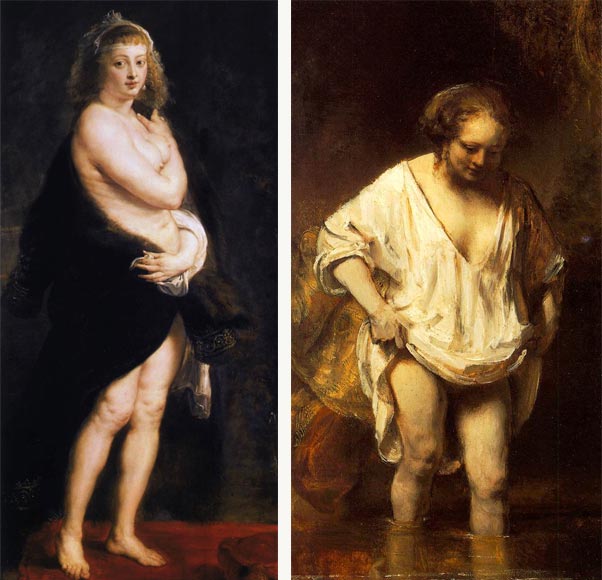
Fig. 12 et 13 à gauche : Rubens, La petite pelisse, 1638, Kunsthistorisches Museum, Vienne. A droite : Rembrandt, Hendrickje se baignant dans une rivière, 1654, National Gallery, Londres.
Dans les deux cas il s’agit du portrait de la deuxième jeune compagne de chacun des peintres. Agé de 53 ans, Rubens est remarié avec Hélène Fourment (16 ans) et Rembrandt à 43 ans a pris comme compagne Hendrickje Stoffels (22 ans).
Hélène Fourment, qui nous regarde droit dans les yeux, tout en effectuant un geste de pseudo-chasteté sans espoir, s’enveloppe sans rien nous cacher dans une fourrure noire. Spécialité du peintre et touche de dramatisme baroque : le puissant contraste de cette fourrure avec la chaire pâlotte, par sa couleur et sa matière provoque inévitablement les instincts primaires. Que les collectionneurs aient baptisé ce tableau « la petite pelisse » n’est guère étonnant.
Paradoxalement, Hendrickje, qui pourtant lève sa jupe, ne suscite aucun frisson érotique ! Sa démarche hésitante dans l’eau fraîche s’accompagne d’un sourire confiant. Le spectateur n’est pas un voyeur ou un intrus, mais quelqu’un d’invité à partager un moment de bonheur.
Pour devenir arme politique, cet amour universel, l’agapè, ne peut se limiter à une vague idée sentimentale ou romantique. Pour cela, les ailes de la philosophie doivent lui fournir hauteur et raison, et la force de s’y maintenir.
Suzanne et les vieillards
Autre exemple utile : l’histoire de Suzanne et les vieillards. Comenius, qui l’utilisa souvent, en était tellement ému qu’il nomma sa fille Zuzanna en 1643, et son fils Daniel en 1646. Cette parabole de la Bible (Daniel 13) reprend le concept grec de justice, déjà présent dans des tragédies grecques comme Antigone de Sophocle, où une jeune femme, au nom d’une loi supérieure, défie les lois de la cité.
Loin des regards, la belle Suzanne, se fait surprendre pendant sa baignade par deux juges qui lui font un chantage : soit tu couches avec nous, soit nous t’accusons d’avoir eu une relation avec un jeune homme qui s’est enfuit ! Suzanne se met à crier et refuse d’entrer dans leur jeu. Accusé devant les siens par les juges (les plus forts), Daniel, un jeune convaincu de son innocence, prend la défense de Suzanne et démontre le faux témoignage des juges qui subiront la peine prévue pour Suzanne.
Chez Rubens, (Suzanne et les vieillards) [FIG13] une voluptueuse Suzanne jette un regard désespéré en l’air pour réclamer l’aide du ciel. Le tableau incarne l’idéologie dominante de la Contre-Réforme : comme pour les protestants les plus radicaux, le libre arbitre n’existe pas.
Chez les protestants, l’âme est prédestinée au bien ou au mal, et quelles que soient leurs actions, cela ne change rien ; chez les Contre-Réformés catholiques, c’est la même chose, mais là on peut toujours tenter d’invoquer la clémence de Dieu dans le cadre des rites (et en payant des indulgences) : « Hors de l’église, point de salut ! ».
D’une façon spectaculaire, chez Rembrandt (Suzanne et les vieillards) [FIG14], une chaste Suzanne lance un regard perçant vers le spectateur et le prend à témoin de son malheur. Seras-tu le nouveau Daniel ? Auras-tu le courage d’intervenir contre les lois de la Cité afin de défendre une justice « divine » ? Ainsi l’agapè est aussi un amour infini pour la justice et la vérité.
Platon contre Aristote
Que Rembrandt fut un philosophe est généralement contesté, voire démenti. Puisque l’inventaire (lors de sa mise en faillite forcée par ses ennemis) de 1654 ne mentionne aucun livre en dehors d’une grosse bible, les écrivains romantiques nous ont souvent dépeint un Rembrandt « poète maudit », génie narcissique, fils de meunier peu instruit faisant fi de la littérature et de la philosophie. Aristote contemplant le buste d’Homère [FIG15] nous démontre le contraire.
-

Fig. 15 : Rembrandt, Aristote contemplant le buste d’Homère, 1653, Metropolitan, New York.
Commandité par l’aristocrate italien Don Antonio Ruffo, le tableau représente Aristote costumé en courtisan idéal : chemise ample, large chapeau noir et surtout décoré d’une pesante chaîne d’or, bref, habillé comme Castiglione, l’Arétin, le Titien et Rubens… Rembrandt démontre ici une connaissance très fine des ennemis du républicanisme, ayant compris que l’aristotélisme est la quasi-religion de l’oligarchie depuis Aristote. Le tableau se moque violemment d’un savoir empirique esclave de la perception des sens. Avec Erasme de Rotterdam, Rembrandt semble affirmer que « l’expérience est l’école des fous ! ». Incapable de voir avec des yeux vides de lumière, Aristote tâtonne d’une main incertaine le crâne du buste d’Homère dont il est supposé être un commentateur réputé. Homère, le poète grec devenu aveugle, le regarde avec les yeux ouverts de l’esprit. Cette inversion des rôles est renforcée dans la composition par la source de lumière, située tangentiellement derrière le buste du poète. Sous le chapeau d’Aristote, des reflets lumineux créent une image fantôme d’oreilles d’ânes, symbole renaissant des âneries scolastiques d’Aristote.
Il est utile d’opposer à l’aveuglement aristotélicien la clairvoyance de Siméon que l’on voit dans le tableau de Rembrandt retrouvé sur son chevalet après sa mort Le Vieillard Siméon avec l’enfant Jésus dans le temple [FIG16].
Toute sa vie, Siméon avait espéré voir le Christ de ses propres yeux. Mais, en vieillissant, son espoir s’estompa de pair avec sa vue. Se rendant quotidiennement au temple, un jour Marie lui demanda de tenir son enfant dans ses bras. Une joie immense envahit alors Siméon, qui, bien qu’aveugle, voyait le Christ bien mieux que quiconque.
Rembrandt a voulu nous léguer cette conviction : ne croyez pas ce que vous voyez, mais croyez et agissez dans un dessein divin et vous le verrez. Sur les mains du peintre on voit un ensemble de tâches qui pourraient former une boule en cristal, renforçant le coté prophétique du sujet.
La Pièce aux cents florins
Cette philosophie se manifeste également dans l’eau-forte connue sous le nom de Pièce aux cents Florins (Le Christ prêchant aux infirmes) [FIG17].
Pendant plus de six ans, Rembrandt y travailla d’arrache-pied. Rien que pour sculpter le visage du Christ, fils de Dieu et fils des hommes et donc sujet excessivement difficile, il n’exécuta pas moins de six portraits à l’huile de jeunes rabbins d’Amsterdam. Une comparaison avec La Cènede Léonard de Vinci dévoile que la fresque de Léonard fut le point de départ pour la composition. Rembrandt l’étudia, et en fit des croquis d’après des reproductions de l’époque. Surtout, l’analyse des rayures de la plaque de cuivre montre que la position des mains du Christ était à l’origine identique à celles de la Cène de Léonard.
Loin des coups de projecteurs qui caractérisent l’univers théâtral et illusionniste qui va du Caravage à Hitchcock, l’œuvre évoque le « mythe de la caverne » de Platon, et l’on y retrouve le Christ bénissant des malades au centre d’un sombre caveau. Transfigurés, et un peu aveuglés, tels les prisonniers dans l’opéra Fidelio de Beethoven, ils marchent vers le Christ. Touchés par sa lumière divine, ils deviennent des philosophes. On reconnaît, entre autres, Homère et Aristote (qui lui, se détourne du Christ), Erasme de Rotterdam et Saint-Pierre figuré (selon certaines sources) avec les traits de Socrate (qu’Erasme appelle « Saint-Socrate »).
La gravure réunit dans un même instant plusieurs séquences décrites dans le chapitre XIX de l’Evangile selon Saint Mathieu : « Laissez venir à moi les petits enfants et ne les empêchez point, car le Royaume des cieux est à ceux qui sont comme eux ». Ainsi d’un geste puissant, le Christ écarte même le meilleur « savoir savant » au profit de l’amour quand Pierre tente de barrer la route aux enfants que les femmes présentent à Jésus.
Tout près est assise la figure méditative du jeune homme riche qui chercha la vie éternelle mais hésita à vendre toutes ses possessions pour en donner le produit aux pauvres. Lorsqu’il fut parti, Jésus songeur, constata tristement qu’il est plus aisé pour un chameau (représenté sous l’arche d’entrée, à droite) de passer par le chas d’une aiguille que pour un homme riche d’entrer au royaume éternel.
Dans un espace qui se situe au-delà de la succession d’instants éphémères, l’action se déroule dans « le temps de tous les temps », dans un instant de l’éternité où les esprits se mesurent à l’universel, dans une espèce de « Jugement dernier » de la conscience divine et philosophique.
La guérison des malades est le point de rupture articulant les deux univers, la souffrance et le bonheur, les ténèbres et la lumière. Le Christ, par son amour, métaphorisé en lumière, guérit et transforme les malades pour en faire des rois-philosophes. Ces philosophes deviennent ainsi des apôtres assis à ses cotés et à la même hauteur que les apôtres dans la Cène de Léonard.
Par sa lumière, le Christ élève les hommes à son image vivante et ses élèves deviennent eux-mêmes source de lumière, capable de rayonner.
Cette « lumière d’Agapè » est le seul fondement philosophique à l’origine de la révolution technique de Rembrandt : au lieu de commencer l’œuvre sur un fond blanc ou de couleur claire (ce qu’on appelle une « impression »), toute l’œuvre tardive est peinte sur une impression sombre, voire noire ! Ensuite, le travail en pâte épaisse, grâce à l’utilisation de la térébenthine de Venise et l’incorporation dans la matière picturale de cire d’abeilles, ramène Rembrandt à des techniques proches de l’encaustique décrites par Pline l’ancien, comme celle employée par Appelles sous Alexandre le Grand et par les peintres du Fayoum en Egypte. Par l’inversion de la gamme de couleurs et une grande économie de moyens, réduisant la palette à moins de six couleurs, Rembrandt fera du peintre un « sculpteur de lumière ». Johannes Vermeer, à sa façon, reprendra cette démarche.15
Privée de gloire terrestre après leur disparition, Rembrandt et Comenius furent immédiatement condamné à l’oubli par le système oligarchique. Mais leurs vies représentent une victoire importante pour l’humanité. Leur bataille politique, philosophique, éducationnelle et esthétique contre l’oligarchie et ses valets, tel Rubens, les fait entrer dans l’éternité. Ils sont et resteront une source inépuisable d’inspiration pour les combats d’aujourd’hui et de demain.
Notes :
1 Karel Vereycken, Rembrandt, bâtisseur de nations, Nouvelle Solidarité, 10 et 17 juin 1985.
2 Olivier Cauly, Comenius, note de bas de page p. 77, Editions du Félin, Paris, 1995.
3 Brochure sur ce tableau du Nationalmuseum de Stockholm.
4 Pour en finir avec des années de harcèlement financier provenant de la famille de Saskia van Uylenburgh, mais avec des vues politiques précises : faire taire le peintre ; Rembrandt demande le 14 juillet 1656 à la Haute Cour de Hollande une cessio bonorum(cession de biens au bénéfice des créanciers).
5 Henriette L.T. de Beaufort, Rembrandt, p. 105, HDT Willinck Zoon, Haarlem, 1957.
6 Samuel Hartlib and Universal Reformation, p. 358, Cambridge University Press, 1994.
7 Bob van den Bogaert, Goethe Rembrandt, p. 12-13, Amdsterdam University Press, Amsterdam 1999.
8 Marcelle Denis, Comenius, pédagogies pédagogues, p.25, PUF, 1994.
9 Constantijn Huygens (1596-1687), était un érudit d’une précocité exceptionnelle. Homme politique, scientifique, moraliste, compositeur de musique, il jouait du violon à l’âge de six ans et écrivait des poèmes en Néerlandais, Latin, Français, Italien, Espagnol, Anglais et Grec. Sa satire ‘T Kostelick Mal (la folie chère) (à l’opposé du Profijtelijk Vermaak= l’amusement profitable) se moque des caprices de la Cour et de la mode « beaumondiste » alors en vogue. C’est le père de Christiaan Huyghens, brillant scientifique et collaborateur de Leibniz à l’Académie des Sciences de Paris.
10 Concile de Trente : « le Saint concile statue qu’il n’est permis à personne, dans aucun lieu ou église, même exempte, de placer ou de faire placer une image inhabituelle, à moins que celle-ci n’ait été approuvée par l’évêque. » « enfin toute indécence sera évitée, en sorte que les images ne soient ni peintes, ni ornées d’une beauté provocante » P.1575-1577, t. II-2, dans G. Alberigo, Les Conciles œcuméniques, repris par Alain Tallon (p.132) dans Le concile de Trente, Editions du CERF, Paris, 2000.
11 Simon Schama, Rembrandt’s eyes, p. 172, Knopf, New York, 1999.
12 Simon Schama, L’embarras de richesses, La culture hollandaise au Siècle d’Or, p. 471, Gallimard, Paris, 1991.
13 Otto Sperling, le médecin de Christian IV, cité par Marie-Anne Lescouret dans Pierre-Paul Rubens, p. 117, JCLattès, Paris, 1990.
14 Martin Luther King, Aimer vos ennemis, sermon de Montgomery (Alabama), en la Baptist Church de Dexter Avenue, le 17 novembre 1957. Repris dans Martin Luther King, Minuit, quelqu’un frappe à la porte, p. 63, Bayard, Paris, 2000.
15 Johannes Vermeer de Delft était un ami de Karel Fabritius, de loin le meilleur élève de Rembrandt, mort dans l’explosion d’une poudrière à trente-quatre ans. Vermeer en sera l’exécuteur testamentaire. A son tour, Anthonie van Leeuwenhoeck, l’inventeur du microscope et correspondant de Leibniz sera l’exécuteur testamentaire de Johannes Vermeer, tâche qu’on attribua toujours à quelqu’un de très proche. Cette filiation ne fait que démontrer l’interconnexion constante entre le monde de la science et celui des arts plastiques. L’école « intimiste » hollandaise, dont Vermeer est le représentant le plus accompli, n’est que l’expression d’une transcendance « métaphysique » dans la beauté « divine » des scènes du quotidien.
Bibliographie
-
- Baudiquey, Paul, Le retour du prodigue, Editions Mame, 1995, Paris.
- Bély, Lucien, L’Europe des Traités de Westphalie, esprit de la diplomatie et diplomatie de l’esprit, Presses Universitaires de France, Paris, 2000.
- Callot, Jacques, etchings, Dover, New York, 1974.
- Castiglione, Baldassare, Le Livre du Courtisan, GF-Flammarion, 1991.
- Cauly, Olvier, Comenius, Editions du Félin, Paris, 1995.
- Clark, Kenneth, An introduction to Rembrandt, Readers Union, Devon, 1978.
- Comenius, La Grande Didactique, Editions Klincksieck, Paris, 1992.
- Denis, Marcelle, Comenius, Presses Universitaires de France, Paris 1994.
- Descargues, Pierre, Rembrandt, JCLattès, 1990.
- Goethe Rembrandt, Tekeningen uit Weimar, Amsterdam University Press, 1999.
- Grimberg, Carl, Histoire Universelle, Marabout Université, Verviers, 1964.
- Haak, B., Rembrandt, zijn leven, zijn werk, zijn tijd, De Centaur, Amsterdam.
- Hobbes, Thomas, Le Citoyen ou les fondements de la politique, Garnier Flammarion, Paris, 1982.
- Jerlerup, Törbjorn, Sweden und der Westphalische Friede, Neue Solidarität, mai 2000.
- King, Martin Luther, Minuit, quelqu’un frappe à la porte, Bayard, Paris, 2000.
- Komensky, Jan Amos, Le labyrinthe du monde et le paradis du cœur, Desclée, Paris, 1991.
- Lescourret, Marie Anne, Pierre-Paul Rubens, JC Lattès, Paris, 1990.
- Marienfeld Barbara, Johann Amos Comenius : Die Kunst, alle Menschen alles zu lehren. Neue Solidarität.
- Rembrandt and his pupils, Nationalmuseum, Stockholm, 1993.
- Sénèque, Entretiens, Editions Bouquins, Paris, 1993.
- Schama Simon, Rembrandt’s Eyes, Knopf, New York 1999.
Schama, Simon, L’embarras de richesses, La culture hollandaise au Siècle d’Or, Gallimard, 1991.
- Schiller, Friedrich, traduction de Regnier, Vol. 6, Histoire de la Guerre de Trente ans, Paris, 1860.
- Sutton, Peter C., Le Siècle de Rubens, Mercatorfonds, Albin Michel, Paris, 1994.
- Tallon, Alain, Le Concile de Trente, CERF, Paris, 2000.
- Tümpel, Christian, Rembrandt, Fonds Mercator-Albin Michel, 1986.
- Van Lil, Kira, La peinture du XVIIème siècle aux Pays-Bas, en Allemagne et en Angleterre, dans l’art du Baroque, Editions Köneman, 1998, Cologne.
